Paul van Yperen's Blog, page 163
April 20, 2021
Polin
French comedian Polin (1863-1927) was one of the greatest stars of the café-concerts of Paris. His interpretations were sober and had nuance and finesse, which were rare in the café-concerts at the time. From 1910 on, he also appeared in film and theatre, including Sacha Guitry's play 'Le Grand Duc' (1921) with Lucien & Sacha Guitry and Yvonne Printemps.
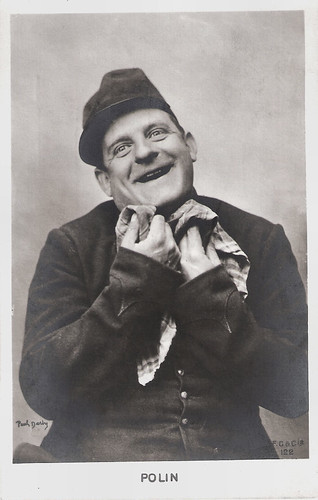
French postcard by F.C. & Co., no. 122. Photo: Paul Darby.
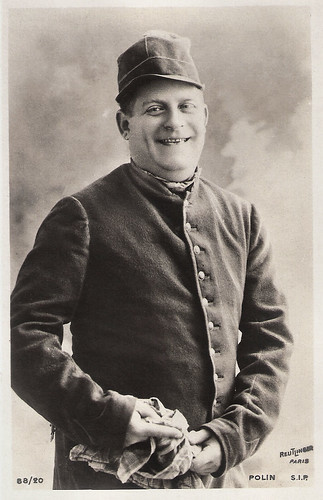
French postcard by S.I.P., no. 88/20. Photo: Reutlinger, Paris.
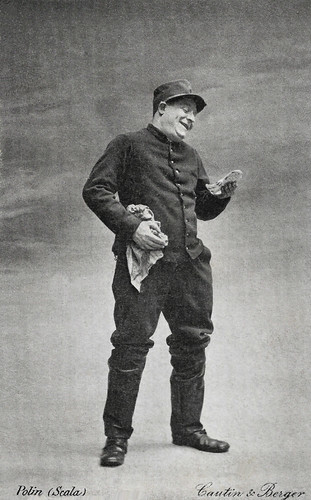
French postcard in the series Nos Artistes, no. 251. Photo: Cautin & Berger. Caption: Polin (Scala). Sent by mail in 1905.
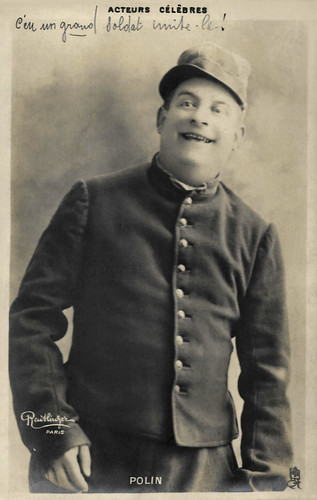
French postcard by Raphael Tuck & Fils Editeurs, Paris, in the series 400. Photo: Reutlinger, Paris. Sent by mail in 1910.
The comic trooper
Pierre Paul Marsalès, also known as Polin, was born in 1863 in Paris, France. He was the only son of a Quercine father, Pierre Marsalès, born in the Quercy in the southwest region of France, and a Basque mother, Marie Anne Etcheto, born in the Pyrénées-Atlantiques department in southwestern France. Nothing in his family environment predestined him to approach an artistic career, but he had a passion for the 'chanson'.
In 1886, Polin made his stage debut in a small venue in his neighbourhood in Paris, the Concert de la Pépinière. Soon followed bigger café-concerts like Eden-Concert and the Alcazar d'été. Polin became famous when he appeared at the Ambassadeurs. In 1892, he took his first steps in the theatre. He played a role in a play by Georges Feydeau which was a huge success: 'Champignol malgré lui' (Champignol in spite of himself).
From 1893 on, Polin performed for twenty years at the music-hall La Scala at the boulevard de Strasbourg. He specialised in a genre called 'le comique troupier' (literally 'comic trooper'), in which Éloi Ouvrard already excelled. Dressed on stage in military uniforms, these troopers performed monologues or comic songs related to the life of a soldier.
Among Polin's greatest successes were: 'Le P'tit Objet' (by French composer Vincent Scotto), 'La Caissière du Grand Café' (The Cashier of the Grand Café), 'L'Ami Bidasse', 'Suzon la blanchisseuse' (Suzon the laundress), 'La Petite Tonkinoise' (Scotto's first success), and 'Le Trottoir (roulant) de l'Exposition (Universelle 1900 de Paris)' (The (rolling) sidewalk of the 1900 Universal Exposition in Paris). These songs were recorded on the cylinders of that time. Many were later reissued on CD.
In 1905, he made his first film appearances in a series of 2-minute shorts by director Alice Guy produced by Gaumont. In Polin, l'anatomie du conscrit/Polin Performs 'The Anatomy of a Draftee' (Alice Guy, 1905), Polin sings a comic song about being in the army. Other films from this series were the short comedies Marché émoustillante (1905) and La Vénus du Luxembourg (1905).
At IMDb , Bob Lipton writes about these shorts: "From 1905 through the outbreak of the First World War, there were a goodly number of sound films shot, most of them musicals of one kind or another. Eventually, they turned out to be novelties and little more, limited by technical issues of synchronizing the film with the records of the sound, and the financial problems caused by the expense of maintaining the venues that could show the films. The sound playback systems did not have much power, which is why old records had such huge trumpets to get the sound to the listeners' ears.
From 1910 on, Polin also appeared again in a few films. The first was the historical drama Vitellius (Henri Pouctal, 1910). Moving Picture World wrote about the film: "This masterful production personifies the evil of two of the cardinal sins, lust, and gluttony. The first of these is shown in the fate of Emperor Vitellius who fell in love with the vestal who was considered the most beautiful and holy of all. He makes known his desire to have her, but the chief of the church vehemently denies him. Whereupon Vitellius, young and impetuous, determines to take her by force."
Four years later he appeared with Germain and Lucy Jousset in the short silent drama Papillon dit Lyonnais Le Juste (Henri Pouctal, 1914), based on a play by Louis Bénière. Another film appearance was in the short comedy C'est pour les orphelins/For the Children (Louis Feuillade, 1916) with Marcel Lévesque , Musidora , and René Poyen . It gives a tiny peek at what it must have been like on Louis Feuillade's sets. His final film was the comedy Polin restera garçon/Polin stays a boy (Maurice Poggi, 1917).
Polin died of a heart disease in 1927 in La Frette-sur-Seine, France. He was 63. From 1906 till his death, he was married to Françoise Mazedier. Polin is buried at the Père Lachaise.
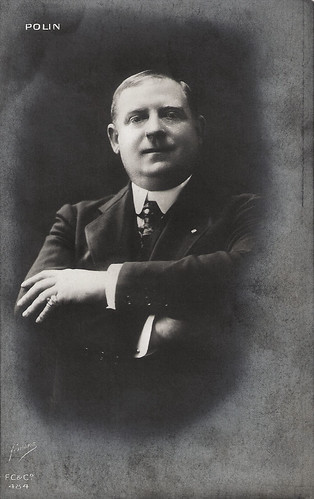
French postcard by F.C. & Co., no. 484. Photo: Femina.
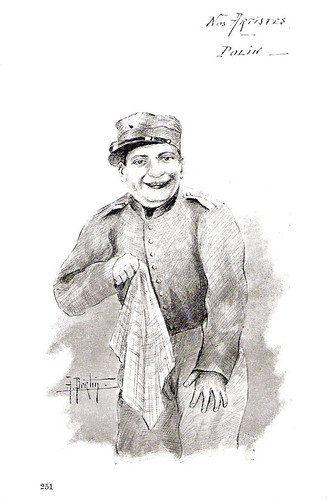
French postcard in the series Nos Artistes, no. 251. Picture: J. Bertin.
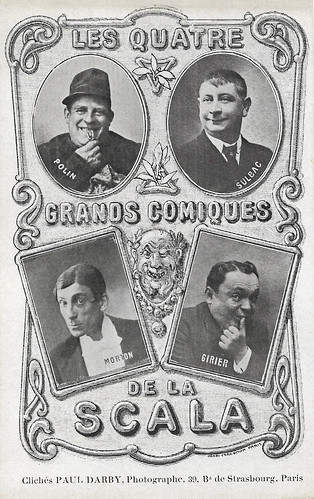
French postcard by Henri Chaumison, Paris for the Scala in Paris. Photos: Paul Darby, Paris. Caption: Les quatre grands comiques de la Scala: Polin, Sulbac, Morton, Girier (The four great comedians of the Scala).
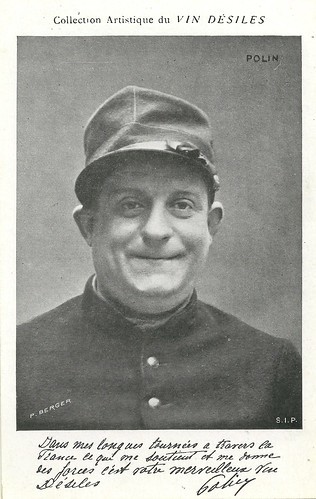
French postcard by S.I.P. Photo: P. Berger. Publicity for Vin Désiles. Caption: Dans mes longues tournées à travers la France ce qui me soutient et me donne des forces c'est votre merveilleux Vin Désiles. (During my long tours across France, it is your wonderful Vin Désiles that supports me and gives me strength.)
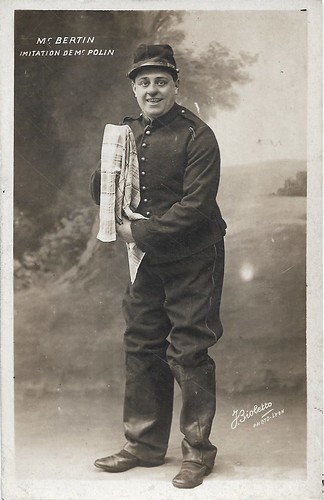
French postcard. Photo: J. Bioletto, Lyon. Mr. Bertin in his imitation of Polin.
French comedian Polin was so popular that he even had imitators. Robert Bertin imitated various famous music-hall artists on stage and did Fregoli -like rapid transformations from one impersonation to another. He was famous for his female impersonations such as those of Polaire , Yvette Guilbert , Mme Miette, and Mlle. Foscolo. He also had a good female voice to accompany him whenever necessary. Moreover, he was also an excellent magician, ventriloquist, and acrobat. J. Bioletto was a photographer who had a photo studio at 51-53 Place de la République, Lyon (another address was 12, rue du Bat d'Argent). Bioletto must have been active between the late 19th century and the First World War.
Polin in Polin, l'anatomie du conscrit/Polin Performs 'The Anatomy of a Draftee' (Alice Guy, 1905). Source: Tonytony9291 (YouTube).
Sources: Jean-François Chariot (Polin le premier tourlourou de France - French), Wikipedia (French), and .

French postcard by F.C. & Co., no. 122. Photo: Paul Darby.

French postcard by S.I.P., no. 88/20. Photo: Reutlinger, Paris.

French postcard in the series Nos Artistes, no. 251. Photo: Cautin & Berger. Caption: Polin (Scala). Sent by mail in 1905.

French postcard by Raphael Tuck & Fils Editeurs, Paris, in the series 400. Photo: Reutlinger, Paris. Sent by mail in 1910.
The comic trooper
Pierre Paul Marsalès, also known as Polin, was born in 1863 in Paris, France. He was the only son of a Quercine father, Pierre Marsalès, born in the Quercy in the southwest region of France, and a Basque mother, Marie Anne Etcheto, born in the Pyrénées-Atlantiques department in southwestern France. Nothing in his family environment predestined him to approach an artistic career, but he had a passion for the 'chanson'.
In 1886, Polin made his stage debut in a small venue in his neighbourhood in Paris, the Concert de la Pépinière. Soon followed bigger café-concerts like Eden-Concert and the Alcazar d'été. Polin became famous when he appeared at the Ambassadeurs. In 1892, he took his first steps in the theatre. He played a role in a play by Georges Feydeau which was a huge success: 'Champignol malgré lui' (Champignol in spite of himself).
From 1893 on, Polin performed for twenty years at the music-hall La Scala at the boulevard de Strasbourg. He specialised in a genre called 'le comique troupier' (literally 'comic trooper'), in which Éloi Ouvrard already excelled. Dressed on stage in military uniforms, these troopers performed monologues or comic songs related to the life of a soldier.
Among Polin's greatest successes were: 'Le P'tit Objet' (by French composer Vincent Scotto), 'La Caissière du Grand Café' (The Cashier of the Grand Café), 'L'Ami Bidasse', 'Suzon la blanchisseuse' (Suzon the laundress), 'La Petite Tonkinoise' (Scotto's first success), and 'Le Trottoir (roulant) de l'Exposition (Universelle 1900 de Paris)' (The (rolling) sidewalk of the 1900 Universal Exposition in Paris). These songs were recorded on the cylinders of that time. Many were later reissued on CD.
In 1905, he made his first film appearances in a series of 2-minute shorts by director Alice Guy produced by Gaumont. In Polin, l'anatomie du conscrit/Polin Performs 'The Anatomy of a Draftee' (Alice Guy, 1905), Polin sings a comic song about being in the army. Other films from this series were the short comedies Marché émoustillante (1905) and La Vénus du Luxembourg (1905).
At IMDb , Bob Lipton writes about these shorts: "From 1905 through the outbreak of the First World War, there were a goodly number of sound films shot, most of them musicals of one kind or another. Eventually, they turned out to be novelties and little more, limited by technical issues of synchronizing the film with the records of the sound, and the financial problems caused by the expense of maintaining the venues that could show the films. The sound playback systems did not have much power, which is why old records had such huge trumpets to get the sound to the listeners' ears.
From 1910 on, Polin also appeared again in a few films. The first was the historical drama Vitellius (Henri Pouctal, 1910). Moving Picture World wrote about the film: "This masterful production personifies the evil of two of the cardinal sins, lust, and gluttony. The first of these is shown in the fate of Emperor Vitellius who fell in love with the vestal who was considered the most beautiful and holy of all. He makes known his desire to have her, but the chief of the church vehemently denies him. Whereupon Vitellius, young and impetuous, determines to take her by force."
Four years later he appeared with Germain and Lucy Jousset in the short silent drama Papillon dit Lyonnais Le Juste (Henri Pouctal, 1914), based on a play by Louis Bénière. Another film appearance was in the short comedy C'est pour les orphelins/For the Children (Louis Feuillade, 1916) with Marcel Lévesque , Musidora , and René Poyen . It gives a tiny peek at what it must have been like on Louis Feuillade's sets. His final film was the comedy Polin restera garçon/Polin stays a boy (Maurice Poggi, 1917).
Polin died of a heart disease in 1927 in La Frette-sur-Seine, France. He was 63. From 1906 till his death, he was married to Françoise Mazedier. Polin is buried at the Père Lachaise.

French postcard by F.C. & Co., no. 484. Photo: Femina.

French postcard in the series Nos Artistes, no. 251. Picture: J. Bertin.

French postcard by Henri Chaumison, Paris for the Scala in Paris. Photos: Paul Darby, Paris. Caption: Les quatre grands comiques de la Scala: Polin, Sulbac, Morton, Girier (The four great comedians of the Scala).

French postcard by S.I.P. Photo: P. Berger. Publicity for Vin Désiles. Caption: Dans mes longues tournées à travers la France ce qui me soutient et me donne des forces c'est votre merveilleux Vin Désiles. (During my long tours across France, it is your wonderful Vin Désiles that supports me and gives me strength.)

French postcard. Photo: J. Bioletto, Lyon. Mr. Bertin in his imitation of Polin.
French comedian Polin was so popular that he even had imitators. Robert Bertin imitated various famous music-hall artists on stage and did Fregoli -like rapid transformations from one impersonation to another. He was famous for his female impersonations such as those of Polaire , Yvette Guilbert , Mme Miette, and Mlle. Foscolo. He also had a good female voice to accompany him whenever necessary. Moreover, he was also an excellent magician, ventriloquist, and acrobat. J. Bioletto was a photographer who had a photo studio at 51-53 Place de la République, Lyon (another address was 12, rue du Bat d'Argent). Bioletto must have been active between the late 19th century and the First World War.
Polin in Polin, l'anatomie du conscrit/Polin Performs 'The Anatomy of a Draftee' (Alice Guy, 1905). Source: Tonytony9291 (YouTube).
Sources: Jean-François Chariot (Polin le premier tourlourou de France - French), Wikipedia (French), and .
Published on April 20, 2021 22:00
April 19, 2021
Photo by Vaselli
Together with Aurelio Pesce and Osvaldo Civirani, Arnaldo Vaselli was one of the founders of Italian stills photography. Already at an early stage, in 1928, he started his career, working for various film companies. He founded one of the longest lasting and active companies in Italian cinema: Foto Vaselli. Vaselli provided the maximum number of Italian film stills. His label was printed on the back of many of his photographs, even if Vaselli had many collaborators.
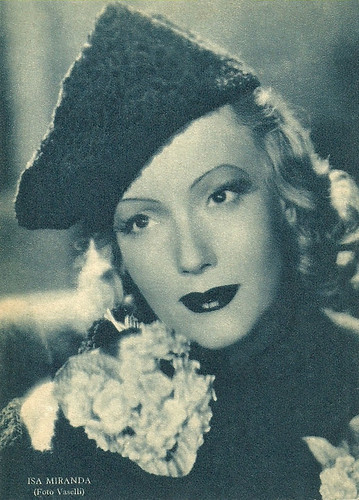
Isa Miranda . Italian postcard by Rizzoli & C., Milano, 1942. Photo: Vaselli.
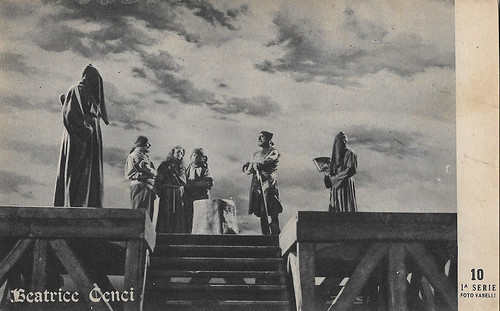
Italian postcard by Casa editrice Albore, Milano. Photo Vaselli / Manenti Film. Part of a set of 10 postcards for the Italian period piece Beatrice Cenci (Guido Brignone, 1941), starring Carola Höhn as the title character. This card shows the beheading of Beatrice Cenci.
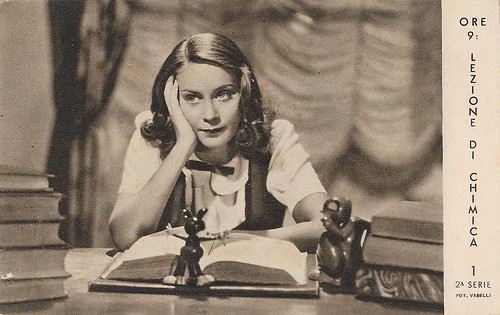
Italian postcard by Casa Editrice Italbore, Milano, no. 1. Photo: Vaselli / Manenti Film. Alida Valli as Anna in Ore 9: lezione di chimica/Schoolgirl Diary (Mario Mattoli, 1941).
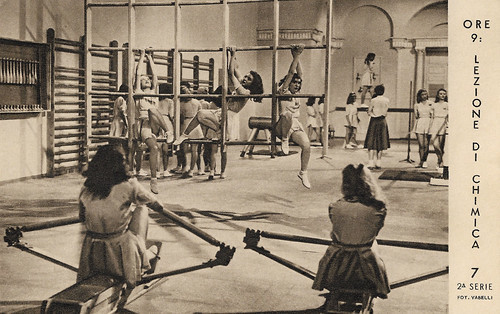
Italian postcard by Casa editrice Italbore, Milano, no. 7. Photo Vaselli / Manenti Film. Publicity card for Ore 9: lezione di chimica/Schoolgirl Diary (Mario Mattoli, 1941), starring Alida Valli .
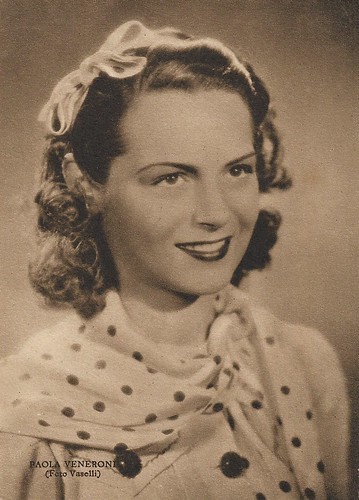
Paola Veneroni. Italian postcard by Rizzoli & C., Milano, 1941. Photo: Vaselli.
A huge production of stills between 1939 and 1943
Foto Vaselli was active between 1936 and 1969. Arnaldo Vaselli started with the stills for Cavallleria (Goffredo Alessandrini, 1936) and ending with L'asino d'oro (Sergio, Spina, 1969). Between 1939 and 1943 Vaselli had a huge production of stills for dozens of film titles: 1939 (15), 1940 (18), 1941 (22), 1942 (31) and 1944 (27).
These included famous titles such as Mille lire al mese (Max Neufeld, 1939), Dora Nelson (Mario Soldati, 1939), La gerla di papà Martin (Mario Bonnard, 1940), La peccatrice (Amleto Palermi, 1940), Addio giovinezza (F.M. Poggioli, 1940), Caravaggio, il pittore maledetto (Alessandrini, 1940), Il pirata sono io! (Mario Mattoli, 1940), Piccolo mondo antico (Soldati, 1941), I promessi sposi (Mario Camerini, 1941), Ore 9: lezione di chimica (Mattoli, 1941), Beatrice Cenci (Guido Brignone, 1941), Malombra (Soldati, 1942), Un colpo di pistola (Renato Castellani, 1942), Fra Diavolo (Luigi Zampa, 1942), Zazà (Castellani, 1942), Bengasi (Augusto Genina, 1942), Fari nella nebbia (Gianni Franciolini, 1942), Le sorelle Materassi (Poggioli, 1943), L'uomo della croce (Roberto Rossellini, 1943), and Gelosia (Poggioli, 1943).
Among these titles were several films with Isa Miranda , Amedeo Nazzari , Macario , Alida Valli and others. The main companies for which Vaselli made his stills then were Lux Film, I.C.I., E.N.I.C., Italcine, and Juventus.
During the war Vaselli did the stils for a few films shot at the FERT studios in Turin, including Documento Z-3 (Alfreo Guarini, 1943), starring Guarini's wife Isa Miranda .
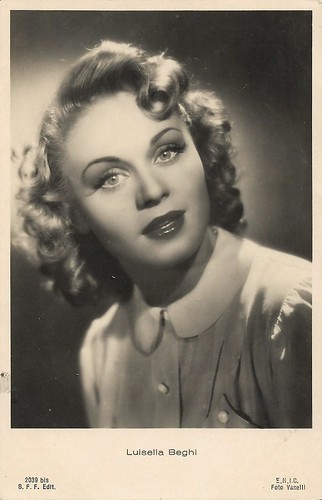
Luisella Beghi. Italian postcard by B.F.F. (Ballerini & Fratini, Florence) Edit., no. 2039. Photo: Vaselli / E.N.I.C.
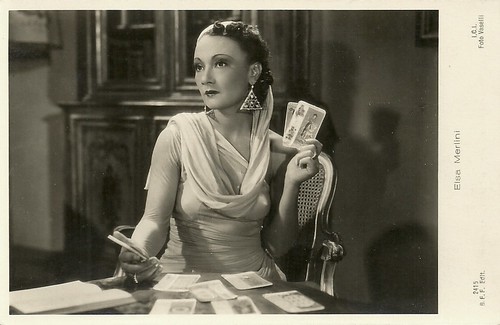
Italian postcard by Ed. B.F.F. (Ballerini & Fratini, Firenze), no. 2415. Photo: Vaselli / ICI. Elsa Merlini in Amicizia (Oreste Biancoli, 1938).
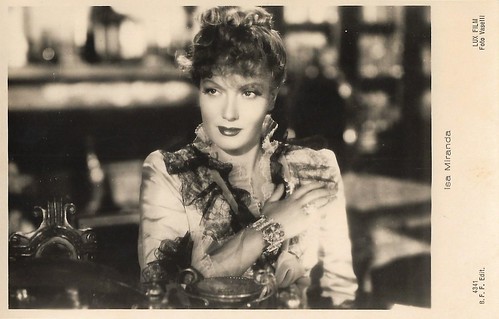
Italian postcard by Ballerini & Fratini, Florence, no. 4341. Photo: Vaselli / Lux Film. Isa Miranda in Malombra (Mario Soldati, 1942), an adaptation from the classic novel by Antonio Fogazzaro.
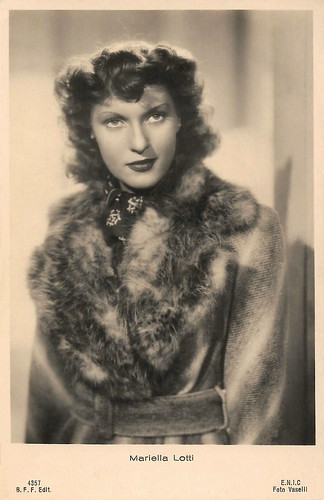
Mariella Lotti . Italian postcard by B.F.F. Edit., no. 4357. Photo: Vaselli / E.N.I.C.
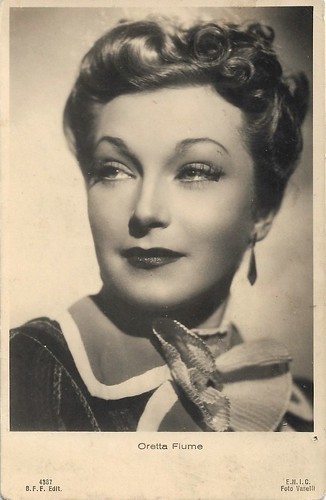
Italian postcard by B.F.F. (Ballerini & Fratini, Florence) Edit., no. 4387. Photo: Vaselli / E.N.I.C. Oretta Fiume in La fabbrica dell'imprevisto (Jacopo Comin, 1942).
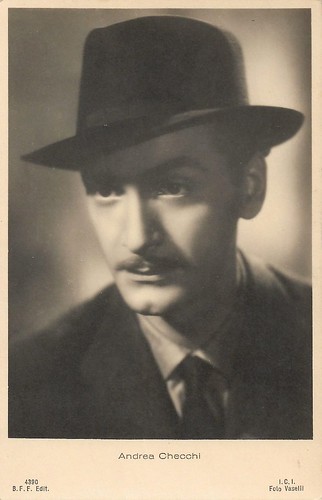
Andrea Checchi . Italian postcard by B.F.F. (Ballerini & Fratini, Florence) Edit., no. 4390. Photo Vaselli / I.C.I.
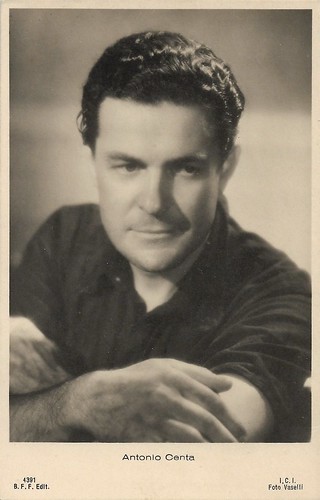
Antonio Centa . Italian postcard by B.F.F. (Ballerini & Fratini, Florence) Edit., no. 4391. Photo: Vaselli / I.C.I.
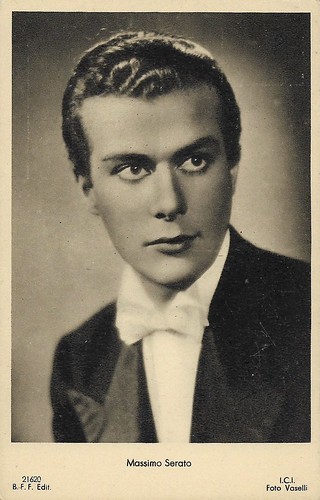
Massimo Serato . Italian postcard by B.F.F. (Ballerini & Fratini, Florence) Edit., no. 21620. Photo Vaselli / I.C.I.
The Sergio Leone trilogy of Spaghetti Westerns
After the war stills production at Vaselli was relative low, though in 1951-1952 a new boom occurred.
In addition to countless lesser known genre films, Vaselli provided the stills for the neorealist films of Luigi Zampa (Vivere in pace, 1946; L'onorevole Angelina, 1947 and Alberto Lattuada (Il delitto di Giovanni Episcopo, 1947), the melodramas of Raffaele Matarazzo (Catene, 1949; Tormento, 1950; I figli di nessuno, 1951), comedies by Mario Mattoli and with Totò , star vehicles for Silvana Pampanini , and many historical films, by both prewar routinés such as Mario Bonnard and Mario Camerini as well as new generations.
Apparently, Vaselli also made the stills for the Sergio Leone trilogy of Spaghetti Westerns Per un pugno di dollari/A Fistful of dollars (1964), Per qualche dollaro in più/For a few dollars more (1965), and Il buono, il brutto, e il cattivo/The Good, The Bad and The Ugly (1966).
Among the professional stills photographers who started their careers with Foto Vaselli were Sandro Baio, Vincenzo Palmarini, Ugo Urbino, Aldo Tonti, and Tonino Benedetti.
From 1937 Foto Vaselli has a photo studio at Via dei Mille 3a in Rome, but the agency also had a subsidiary in Turin, in Via Lombardia 104. The last known address of Vaselli in Rome, dating of 1968, was Via Imperia 2.
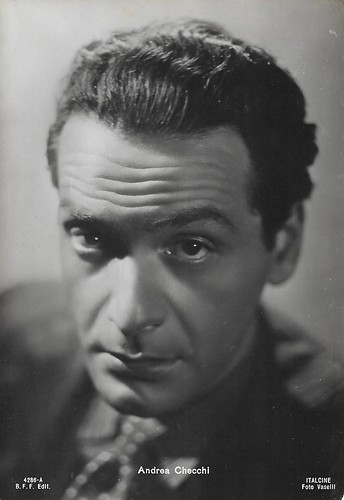
Andrea Checchi . Italian postcard by Casa Editrice Ballerini & Fratini, Firenze (B.F.F. Edit.), no. 4288-A. Photo: Vaselli / Italcine.
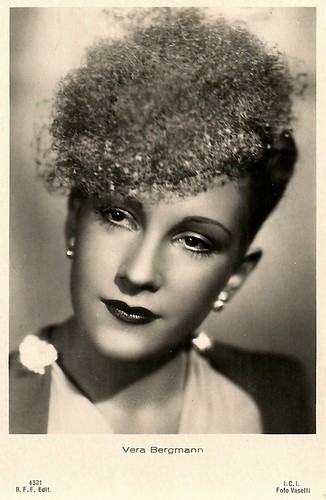
Vera Bergmann aka Bergmann. Italian postcard by Casa Editrice Ballerini & Fratini, Firenze (B.F.F. Edit.), no. 4331. Photo: Vaselli / I.C.I.
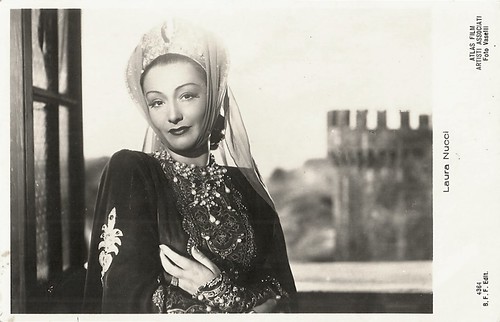
Italian postcard by Casa Editrice Ballerini & Fratini, Firenze (B.F.F. Edit.), no. 4364. Photo: Vaselli / Atlas Film / Artisti Associati. Laura Nucci in Rita da Cascia (Antonio Leonviola, 1943).
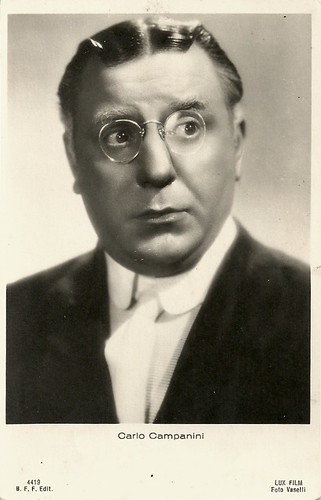
Carlo Campanini. Italian postcard by Casa Editrice Ballerini & Fratini, Firenze (B.F.F. Edit.), no. 4419 Photo: Vaselli / Lux Film.
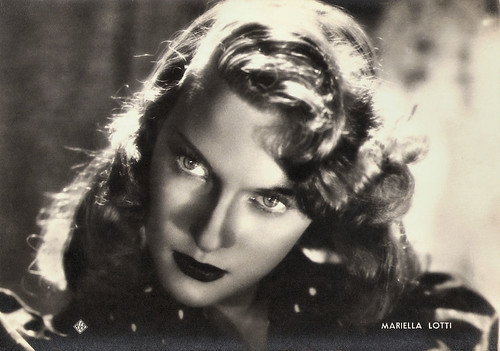
Italian postcard by A. Scarmiglia Ed., Roma (ASER), no. 122. Photo: Vaselli / Fauno Film. Mariella Lotti in Fari nella nebbia/Headlights in the fog (Gianni Franciolini, 1941).
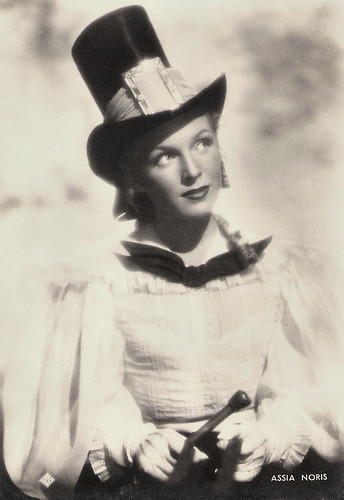
Assia Noris . Italian postcard by A. Scarmiglia Ed., Roma (ASER), no. 166. Photo: Vaselli.
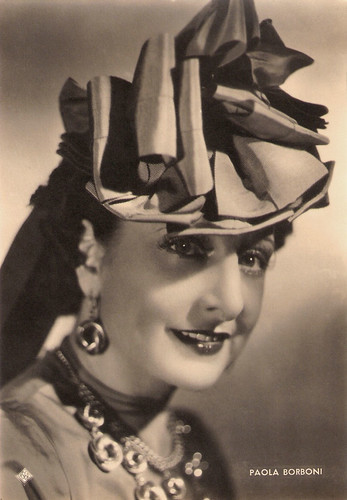
Paola Borboni . Italian postcard by ASER (A. Scarmiglia Edizioni Roma), no. 205. Photo: Vaselli / Lux Film.
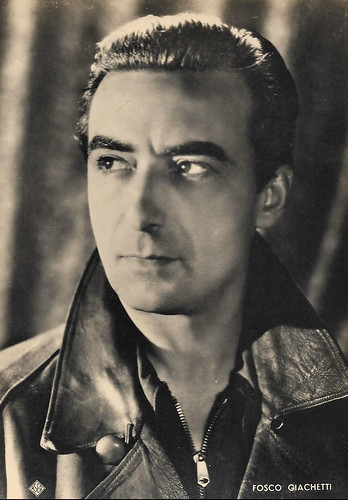
Italian postcard by ASER (A. Scarmiglia Edizioni Roma), no. 226. Photo: Vaselli / Fauno Film. Fosco Giachetti in Fari nella nebbia (Gianni Franciolini, 1942).
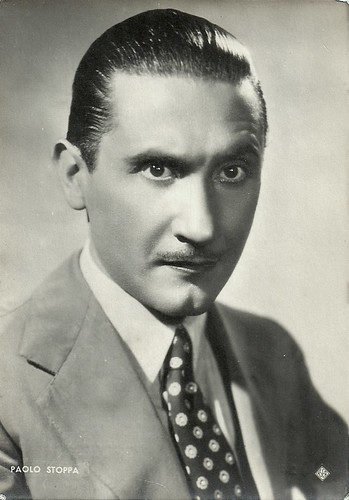
Paolo Stoppa . Italian postcard by ASER (A. Scarmiglia Ed. Roma), no. 241. Photo: Vaselli / Atlas Film.
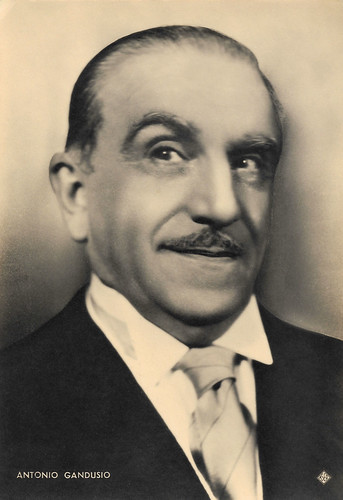
Antonio Gandusio . Italian postcard by ASER (A. Scarmiglia Edizioni Roma), no. 299. Photo: Vaselli / Lux Film.

Italian postcard by ASER, no. 322. Photo: Vaselli / Juventus Film. Evi Maltagliati in Il nemico/The enemy (Guglielmo Giannini, 1943).
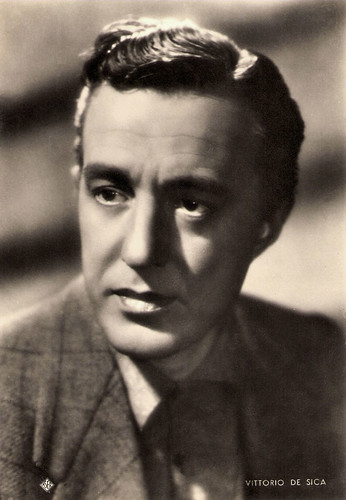
Vittorio De Sica . Italian postcard by Aser, Roma (Rome), no. 333. Photo: Vaselli.
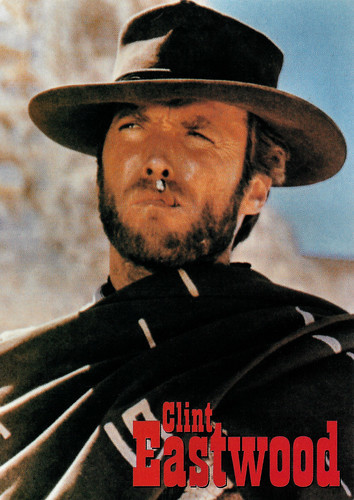
British postcard by Pyramid, Leicester, no. PC2041. Clint Eastwood in Per un pugno di dollari/A Fistful of Dollars (Sergio Leone, 1964).
Source: Elisabetta Bruscolini ed. (Roma nel cinema: Tra realtà e finzione, 2000). With thanks to Viridiana Rotondi (Centro Sperimentale).

Isa Miranda . Italian postcard by Rizzoli & C., Milano, 1942. Photo: Vaselli.

Italian postcard by Casa editrice Albore, Milano. Photo Vaselli / Manenti Film. Part of a set of 10 postcards for the Italian period piece Beatrice Cenci (Guido Brignone, 1941), starring Carola Höhn as the title character. This card shows the beheading of Beatrice Cenci.

Italian postcard by Casa Editrice Italbore, Milano, no. 1. Photo: Vaselli / Manenti Film. Alida Valli as Anna in Ore 9: lezione di chimica/Schoolgirl Diary (Mario Mattoli, 1941).

Italian postcard by Casa editrice Italbore, Milano, no. 7. Photo Vaselli / Manenti Film. Publicity card for Ore 9: lezione di chimica/Schoolgirl Diary (Mario Mattoli, 1941), starring Alida Valli .

Paola Veneroni. Italian postcard by Rizzoli & C., Milano, 1941. Photo: Vaselli.
A huge production of stills between 1939 and 1943
Foto Vaselli was active between 1936 and 1969. Arnaldo Vaselli started with the stills for Cavallleria (Goffredo Alessandrini, 1936) and ending with L'asino d'oro (Sergio, Spina, 1969). Between 1939 and 1943 Vaselli had a huge production of stills for dozens of film titles: 1939 (15), 1940 (18), 1941 (22), 1942 (31) and 1944 (27).
These included famous titles such as Mille lire al mese (Max Neufeld, 1939), Dora Nelson (Mario Soldati, 1939), La gerla di papà Martin (Mario Bonnard, 1940), La peccatrice (Amleto Palermi, 1940), Addio giovinezza (F.M. Poggioli, 1940), Caravaggio, il pittore maledetto (Alessandrini, 1940), Il pirata sono io! (Mario Mattoli, 1940), Piccolo mondo antico (Soldati, 1941), I promessi sposi (Mario Camerini, 1941), Ore 9: lezione di chimica (Mattoli, 1941), Beatrice Cenci (Guido Brignone, 1941), Malombra (Soldati, 1942), Un colpo di pistola (Renato Castellani, 1942), Fra Diavolo (Luigi Zampa, 1942), Zazà (Castellani, 1942), Bengasi (Augusto Genina, 1942), Fari nella nebbia (Gianni Franciolini, 1942), Le sorelle Materassi (Poggioli, 1943), L'uomo della croce (Roberto Rossellini, 1943), and Gelosia (Poggioli, 1943).
Among these titles were several films with Isa Miranda , Amedeo Nazzari , Macario , Alida Valli and others. The main companies for which Vaselli made his stills then were Lux Film, I.C.I., E.N.I.C., Italcine, and Juventus.
During the war Vaselli did the stils for a few films shot at the FERT studios in Turin, including Documento Z-3 (Alfreo Guarini, 1943), starring Guarini's wife Isa Miranda .

Luisella Beghi. Italian postcard by B.F.F. (Ballerini & Fratini, Florence) Edit., no. 2039. Photo: Vaselli / E.N.I.C.

Italian postcard by Ed. B.F.F. (Ballerini & Fratini, Firenze), no. 2415. Photo: Vaselli / ICI. Elsa Merlini in Amicizia (Oreste Biancoli, 1938).

Italian postcard by Ballerini & Fratini, Florence, no. 4341. Photo: Vaselli / Lux Film. Isa Miranda in Malombra (Mario Soldati, 1942), an adaptation from the classic novel by Antonio Fogazzaro.

Mariella Lotti . Italian postcard by B.F.F. Edit., no. 4357. Photo: Vaselli / E.N.I.C.

Italian postcard by B.F.F. (Ballerini & Fratini, Florence) Edit., no. 4387. Photo: Vaselli / E.N.I.C. Oretta Fiume in La fabbrica dell'imprevisto (Jacopo Comin, 1942).

Andrea Checchi . Italian postcard by B.F.F. (Ballerini & Fratini, Florence) Edit., no. 4390. Photo Vaselli / I.C.I.

Antonio Centa . Italian postcard by B.F.F. (Ballerini & Fratini, Florence) Edit., no. 4391. Photo: Vaselli / I.C.I.

Massimo Serato . Italian postcard by B.F.F. (Ballerini & Fratini, Florence) Edit., no. 21620. Photo Vaselli / I.C.I.
The Sergio Leone trilogy of Spaghetti Westerns
After the war stills production at Vaselli was relative low, though in 1951-1952 a new boom occurred.
In addition to countless lesser known genre films, Vaselli provided the stills for the neorealist films of Luigi Zampa (Vivere in pace, 1946; L'onorevole Angelina, 1947 and Alberto Lattuada (Il delitto di Giovanni Episcopo, 1947), the melodramas of Raffaele Matarazzo (Catene, 1949; Tormento, 1950; I figli di nessuno, 1951), comedies by Mario Mattoli and with Totò , star vehicles for Silvana Pampanini , and many historical films, by both prewar routinés such as Mario Bonnard and Mario Camerini as well as new generations.
Apparently, Vaselli also made the stills for the Sergio Leone trilogy of Spaghetti Westerns Per un pugno di dollari/A Fistful of dollars (1964), Per qualche dollaro in più/For a few dollars more (1965), and Il buono, il brutto, e il cattivo/The Good, The Bad and The Ugly (1966).
Among the professional stills photographers who started their careers with Foto Vaselli were Sandro Baio, Vincenzo Palmarini, Ugo Urbino, Aldo Tonti, and Tonino Benedetti.
From 1937 Foto Vaselli has a photo studio at Via dei Mille 3a in Rome, but the agency also had a subsidiary in Turin, in Via Lombardia 104. The last known address of Vaselli in Rome, dating of 1968, was Via Imperia 2.

Andrea Checchi . Italian postcard by Casa Editrice Ballerini & Fratini, Firenze (B.F.F. Edit.), no. 4288-A. Photo: Vaselli / Italcine.

Vera Bergmann aka Bergmann. Italian postcard by Casa Editrice Ballerini & Fratini, Firenze (B.F.F. Edit.), no. 4331. Photo: Vaselli / I.C.I.

Italian postcard by Casa Editrice Ballerini & Fratini, Firenze (B.F.F. Edit.), no. 4364. Photo: Vaselli / Atlas Film / Artisti Associati. Laura Nucci in Rita da Cascia (Antonio Leonviola, 1943).

Carlo Campanini. Italian postcard by Casa Editrice Ballerini & Fratini, Firenze (B.F.F. Edit.), no. 4419 Photo: Vaselli / Lux Film.

Italian postcard by A. Scarmiglia Ed., Roma (ASER), no. 122. Photo: Vaselli / Fauno Film. Mariella Lotti in Fari nella nebbia/Headlights in the fog (Gianni Franciolini, 1941).

Assia Noris . Italian postcard by A. Scarmiglia Ed., Roma (ASER), no. 166. Photo: Vaselli.

Paola Borboni . Italian postcard by ASER (A. Scarmiglia Edizioni Roma), no. 205. Photo: Vaselli / Lux Film.

Italian postcard by ASER (A. Scarmiglia Edizioni Roma), no. 226. Photo: Vaselli / Fauno Film. Fosco Giachetti in Fari nella nebbia (Gianni Franciolini, 1942).

Paolo Stoppa . Italian postcard by ASER (A. Scarmiglia Ed. Roma), no. 241. Photo: Vaselli / Atlas Film.

Antonio Gandusio . Italian postcard by ASER (A. Scarmiglia Edizioni Roma), no. 299. Photo: Vaselli / Lux Film.

Italian postcard by ASER, no. 322. Photo: Vaselli / Juventus Film. Evi Maltagliati in Il nemico/The enemy (Guglielmo Giannini, 1943).

Vittorio De Sica . Italian postcard by Aser, Roma (Rome), no. 333. Photo: Vaselli.

British postcard by Pyramid, Leicester, no. PC2041. Clint Eastwood in Per un pugno di dollari/A Fistful of Dollars (Sergio Leone, 1964).
Source: Elisabetta Bruscolini ed. (Roma nel cinema: Tra realtà e finzione, 2000). With thanks to Viridiana Rotondi (Centro Sperimentale).
Published on April 19, 2021 22:00
April 18, 2021
Carl Alstrup
Carl Alstrup (1877-1942) was a Danish actor, director, screenwriter, theatre director, and singer. During the silent era, he was a popular comic film actor at Nordisk. He appeared in 22 films between 1908 and 1942.
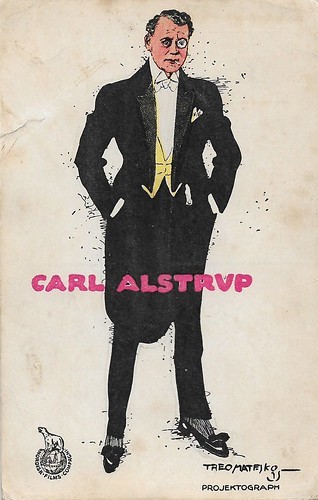
Austrian postcard by Projektograph, Vienna, ca. 1914. Design by Theo Matejko. Based on a photo by Nordisk Films Compagni.
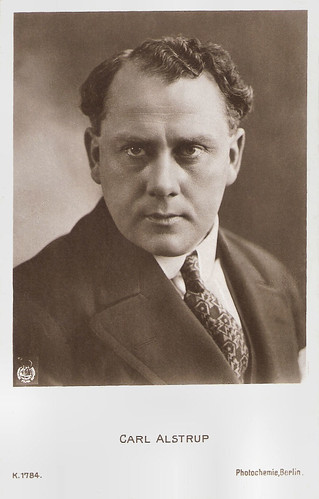
German postcard by Photochemie, no. K. 1784. Photo: Nordisk Film.
A traveling theatre actor all over Denmark
Carl Marius Alstrup was born in 1877 in the Copenhagen district of Sundbyvester, then part of Tårnby, Denmark.
Alstrup made his debut in 1896 as a member of a Danish theater company during a guest appearance in Oslo. From 1896 to 1904, he was a traveling theatre actor all over Denmark.
From 1904 to 1911, he was employed at Frederiksberg Teater and from 1911 to 1913 at Centralteatret, at Scala-Teatret from 1913 to 1922 and from 1923 to 1928, and from 1922 to 1923 at Betty Nansen Teatret. From 1928 he was also director of the Sønderbro Teater.
As a singer, Alstrup also received more attention in his time. His famous songs included: 'Jeg kysser Deres hånd, Madame' (I kiss your hand, Madame) and 'Bobby, du må have ondt i håret' (Bobby, you must have hair pain). The song 'Manden på Risten' (The man on the Risten) from 1936 was best known at that time.
Carl Alstrup also became known through his numerous engagements in many silent films and performances in a whole series of revues, with songs and skits, which were highly regarded at the time.
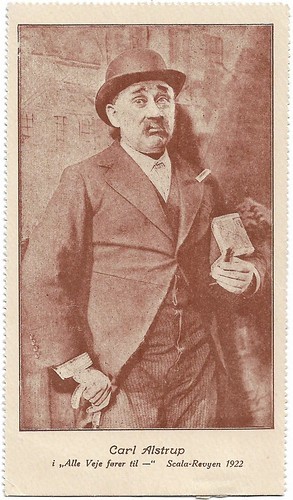
Danish promotional mini-postcard for the Scala-Theater, Copenhagen. Danish film and stage comedian Carl Alstrup in the Scala stage revue 'Alle veje fører til -' (All Roads Lead to ... , 1922).
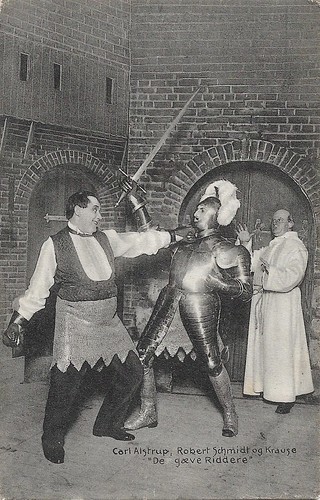
Danish postcard by Stenders Verlag, Eneberettiget, no. 20001. Carl Alstrup, Robert Schmidt, and Krause in the play De gaeve Riddere (The Cool Knight). In 1915 Alstrup would play the lead in the film Den gaeve Riddere by Alfred Cohn, possibly an adaptation of this play.
A toned-down, intimate style
In 1907 Carl Astrup started to work for the Nordisk company and debuted on the screen in Kameliadame by Viggo Larsen , the first film adaptation of Alexandre Dumas fils' famous play 'La dame aux camélias'. In 1908-1909 he would act in many shorts by Larsen for Nordisk.
In 1909 Alstrup moved to Biorama, where he directed his own films, but already in 1910, he was back at Nordisk. There he acted in countless films by Eduard Schnedler-Sørensen such as the comedy Badets Dronning/The Queen of the Season (Eduard Schnedler-Sørensen, 1912), with Else Frölich , and some by August Blom, Robert Dinesen , and others.
From 1915 it was mainly Lau Lauritzen who directed him in many farces with Alstrup in the lead. In 1916-1917 he made a few films at Dania Biofilm but his mainstay was at Nordisk, with Lauritzen.
In 1922-1925 Alstrup again directed three films himself. Alstrup experimented with color film productions long before they hit the market, but his inventions were not patented at the time. By the mid-1920s his very active film career halted.
Alstrup was later involved in the production of some sound films, such as Den kloge mand/The Wise Man (Arne Weel, 1937), Vagabonden/Vagabonds (Arne Weel, 1940), En forbryder/A criminal (Arne Weel, 1941), and Peter Andersen (Svend Methling, 1941). As a film actor, director and screenwriter, he was also involved in many other Danish film productions. All in all, Alstrup acted in over 100 films.
Morten Piil wrote about Carl Alstrup in his book 'Danske filmskuespillere' (2003) on Danish film actors, that while many Danish stage actors who stepped over to film failed, "Carl Alstrup's toned-down, intimate style, on the other hand, still feels modern - and often he is simply excellent. At the theatre, he was highly loved and respected, both as a revue artist and aspiring character actor.
But extensive silent film work had early on made him familiar with the film medium, and it benefited him when Danish film in the late autumn of his career gave him a small handful of good character roles. With his penchant for quirky and steep personalities, he is the equivalent (in all modesty) of Danish film to an Emil Jannings or a Michel Simon ."
Carl Alstrup died in 1942 in Snekkersten, Helsingør Kommune in Denmark. He was 65. Alstrup was married to Ruth Rubin and Sophie Wiegand-Hansen.
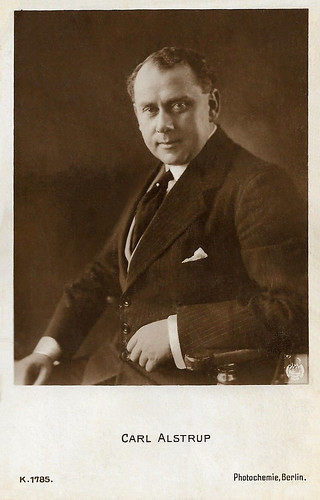
German postcard by Photochemie, Berlin, no. K. 1785. Photo: Nordisk Films Compagni.
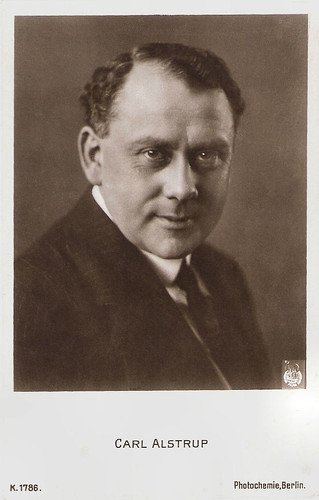
German postcard by Photochemie, no. K. 1786. Photo: Nordisk Film.
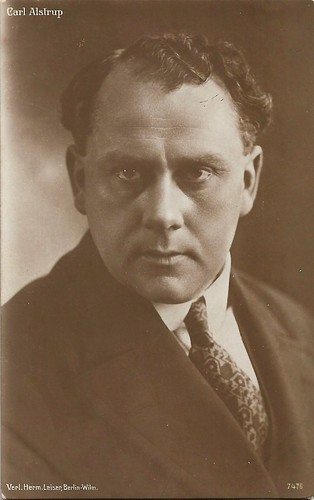
German postcard by Verlag Hermann Leiser, Berlin, no. 7476.
Sources: DFI, Wikipedia (English, German, Danish and Italian), and .

Austrian postcard by Projektograph, Vienna, ca. 1914. Design by Theo Matejko. Based on a photo by Nordisk Films Compagni.

German postcard by Photochemie, no. K. 1784. Photo: Nordisk Film.
A traveling theatre actor all over Denmark
Carl Marius Alstrup was born in 1877 in the Copenhagen district of Sundbyvester, then part of Tårnby, Denmark.
Alstrup made his debut in 1896 as a member of a Danish theater company during a guest appearance in Oslo. From 1896 to 1904, he was a traveling theatre actor all over Denmark.
From 1904 to 1911, he was employed at Frederiksberg Teater and from 1911 to 1913 at Centralteatret, at Scala-Teatret from 1913 to 1922 and from 1923 to 1928, and from 1922 to 1923 at Betty Nansen Teatret. From 1928 he was also director of the Sønderbro Teater.
As a singer, Alstrup also received more attention in his time. His famous songs included: 'Jeg kysser Deres hånd, Madame' (I kiss your hand, Madame) and 'Bobby, du må have ondt i håret' (Bobby, you must have hair pain). The song 'Manden på Risten' (The man on the Risten) from 1936 was best known at that time.
Carl Alstrup also became known through his numerous engagements in many silent films and performances in a whole series of revues, with songs and skits, which were highly regarded at the time.

Danish promotional mini-postcard for the Scala-Theater, Copenhagen. Danish film and stage comedian Carl Alstrup in the Scala stage revue 'Alle veje fører til -' (All Roads Lead to ... , 1922).

Danish postcard by Stenders Verlag, Eneberettiget, no. 20001. Carl Alstrup, Robert Schmidt, and Krause in the play De gaeve Riddere (The Cool Knight). In 1915 Alstrup would play the lead in the film Den gaeve Riddere by Alfred Cohn, possibly an adaptation of this play.
A toned-down, intimate style
In 1907 Carl Astrup started to work for the Nordisk company and debuted on the screen in Kameliadame by Viggo Larsen , the first film adaptation of Alexandre Dumas fils' famous play 'La dame aux camélias'. In 1908-1909 he would act in many shorts by Larsen for Nordisk.
In 1909 Alstrup moved to Biorama, where he directed his own films, but already in 1910, he was back at Nordisk. There he acted in countless films by Eduard Schnedler-Sørensen such as the comedy Badets Dronning/The Queen of the Season (Eduard Schnedler-Sørensen, 1912), with Else Frölich , and some by August Blom, Robert Dinesen , and others.
From 1915 it was mainly Lau Lauritzen who directed him in many farces with Alstrup in the lead. In 1916-1917 he made a few films at Dania Biofilm but his mainstay was at Nordisk, with Lauritzen.
In 1922-1925 Alstrup again directed three films himself. Alstrup experimented with color film productions long before they hit the market, but his inventions were not patented at the time. By the mid-1920s his very active film career halted.
Alstrup was later involved in the production of some sound films, such as Den kloge mand/The Wise Man (Arne Weel, 1937), Vagabonden/Vagabonds (Arne Weel, 1940), En forbryder/A criminal (Arne Weel, 1941), and Peter Andersen (Svend Methling, 1941). As a film actor, director and screenwriter, he was also involved in many other Danish film productions. All in all, Alstrup acted in over 100 films.
Morten Piil wrote about Carl Alstrup in his book 'Danske filmskuespillere' (2003) on Danish film actors, that while many Danish stage actors who stepped over to film failed, "Carl Alstrup's toned-down, intimate style, on the other hand, still feels modern - and often he is simply excellent. At the theatre, he was highly loved and respected, both as a revue artist and aspiring character actor.
But extensive silent film work had early on made him familiar with the film medium, and it benefited him when Danish film in the late autumn of his career gave him a small handful of good character roles. With his penchant for quirky and steep personalities, he is the equivalent (in all modesty) of Danish film to an Emil Jannings or a Michel Simon ."
Carl Alstrup died in 1942 in Snekkersten, Helsingør Kommune in Denmark. He was 65. Alstrup was married to Ruth Rubin and Sophie Wiegand-Hansen.

German postcard by Photochemie, Berlin, no. K. 1785. Photo: Nordisk Films Compagni.

German postcard by Photochemie, no. K. 1786. Photo: Nordisk Film.

German postcard by Verlag Hermann Leiser, Berlin, no. 7476.
Sources: DFI, Wikipedia (English, German, Danish and Italian), and .
Published on April 18, 2021 22:00
April 17, 2021
An Angel at My Table (1990)
An Angel at My Table (Jane Campion, 1990) tells the story of famed New Zealand author Janet Frame. Frame was a brilliant child who, as a shy teen, was misdiagnosed with schizophrenia and sent to a mental hospital where she was treated with electroshocks. The film, originally produced as a television mini-series, was presented in the Netherlands in 1991 by feminist film distributor Cinemien, which also presented a series of four postcards. This was a cooperation with the Dutch publisher De Geus in Breda which presented the Dutch translation of Janet Frame's autobiography.
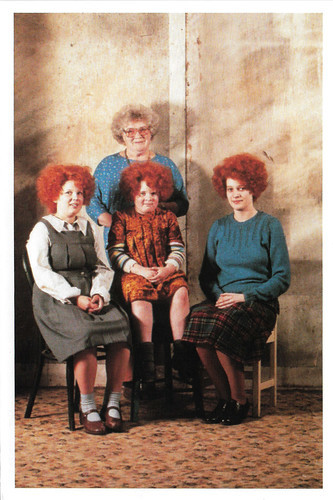
Dutch postcard by De Geus / Hibiscus Films / Cinemien, 1991. Kerry Fox, Alexia Helogh, Karen Fergusson, and Janet Frame at the set of An Angel at My Table (Jane Campion, 1990).
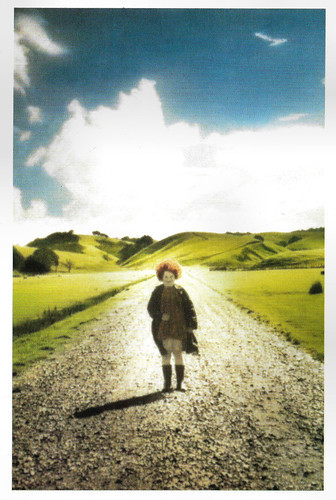
Dutch postcard by De Geus / Hibiscus Films / Cinemien, 1991. Alexia Helogh in An Angel at My Table (Jane Campion, 1990).
Struggling for a place in the world
In the 1920s and 1930s, New Zealand's most famous author Janet Frame (1924-2004) grows up in a poor family with lots of brothers and sisters. Janet is a plump little girl, with an unruly mop of bright red hair. Already at an early age, she is different from the other kids. She is fascinated with books and stories after a friend Lends her a copy of Grimm's fairy tales. Despite financial hardships, her father manages to buy her a journal "for her writings".
By her late teens, she was no longer plump, but a rather crippling shyness had set in. She prefers to be by herself, where she can nurture her passion for creating stories. Janet gets an education as a teacher. After a misdiagnosis of schizophrenia, she stays at a mental institution for eight years and endures more than 200 electroshock treatments even though there was nothing really wrong with her except for shyness and depression.
Janet Frame is even scheduled for a partial lobotomy when news reaches her doctors that she wins a national literary award. During her hospitalisation her sister had published a book of Janet's short stories. She was almost immediately released under the premise that a talented author couldn't possibly need the treatment she had been receiving...
Jane Campion made this biographical drama in between her celebrated debut feature Sweetie (1989) and her Oscar-winning masterpiece The Piano (1993). Campion tells Frame's life story in three 50 minute interludes, based on three of her memoirs, 'To the Is-land' (1982), 'An Angel at My Table' (1984), and 'The Envoy from Mirror City' (1984). Campion made a very affecting and quietly powerful portrait of a gentle and genuinely humble woman. She keeps her main character always in the center, without losing that focus. Janet is excellently played in the different stages of her life by Alexia Helogh (child), Karen Fergusson (adolescent), and Kerry Fox (adult).
In the Chicago Sun-Times , Roger Ebert gave the film 4 out of 4 stars, stating: "[The film] tells its story calmly and with great attention to human detail and, watching it, I found myself drawn in with a rare intensity. (....) Jane Campion's An Angel at My Table tells her [Janet Frame's] story in a way that I found strangely engrossing from beginning to end. This is not a hyped-up biopic or a soap opera, but simply the record of a life as lived, beginning in childhood with a talented, dreamy girl whose working-class parents loved her, and continuing to follow her as she was gradually shunted by society into a place that almost killed her."
An Angel at My Table (Jane Campion, 1990) was the first film from New Zealand to be screened at the Venice Film Festival, where it received multiple standing ovations. In addition to virtually sweeping the local New Zealand film awards, it also took home the prize for the best foreign film at the Independent Spirit Awards and the International Critics' Award at the Toronto International Film Festival. In Venice, the film was awarded the Grand Special Jury Prize despite evoking yells of protest that it did not win The Golden Lion.
An Angel at My Table not only established Jane Campion as an emerging director and launched the career of Kerry Fox, but it also introduced a broader audience to Janet Frame's writing. Frame has written some 20 novels, books of poetry, plays, and autobiographies.
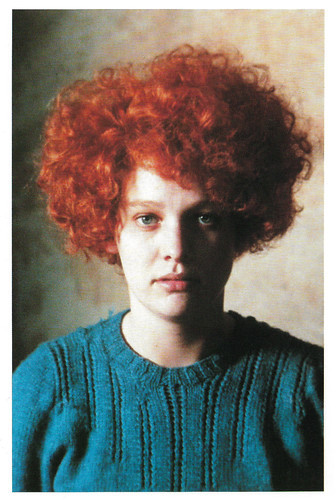
Dutch postcard by De Geus / Hibiscus Films / Cinemien, 1991. Kerry Fox in An Angel at My Table (Jane Campion, 1990).
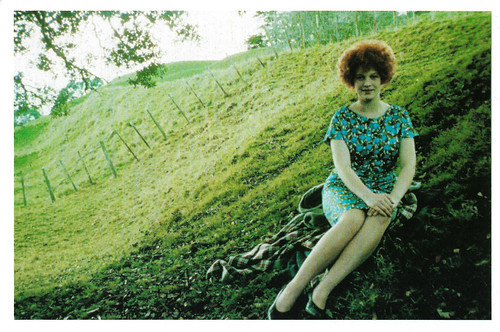
Dutch postcard by De Geus / Hibiscus Films / Cinemien, 1991. Kerry Fox in An Angel at My Table (Jane Campion, 1990).
Source: Roger Ebert (RogerEbert.Com), Wikipedia, and IMDb.

Dutch postcard by De Geus / Hibiscus Films / Cinemien, 1991. Kerry Fox, Alexia Helogh, Karen Fergusson, and Janet Frame at the set of An Angel at My Table (Jane Campion, 1990).

Dutch postcard by De Geus / Hibiscus Films / Cinemien, 1991. Alexia Helogh in An Angel at My Table (Jane Campion, 1990).
Struggling for a place in the world
In the 1920s and 1930s, New Zealand's most famous author Janet Frame (1924-2004) grows up in a poor family with lots of brothers and sisters. Janet is a plump little girl, with an unruly mop of bright red hair. Already at an early age, she is different from the other kids. She is fascinated with books and stories after a friend Lends her a copy of Grimm's fairy tales. Despite financial hardships, her father manages to buy her a journal "for her writings".
By her late teens, she was no longer plump, but a rather crippling shyness had set in. She prefers to be by herself, where she can nurture her passion for creating stories. Janet gets an education as a teacher. After a misdiagnosis of schizophrenia, she stays at a mental institution for eight years and endures more than 200 electroshock treatments even though there was nothing really wrong with her except for shyness and depression.
Janet Frame is even scheduled for a partial lobotomy when news reaches her doctors that she wins a national literary award. During her hospitalisation her sister had published a book of Janet's short stories. She was almost immediately released under the premise that a talented author couldn't possibly need the treatment she had been receiving...
Jane Campion made this biographical drama in between her celebrated debut feature Sweetie (1989) and her Oscar-winning masterpiece The Piano (1993). Campion tells Frame's life story in three 50 minute interludes, based on three of her memoirs, 'To the Is-land' (1982), 'An Angel at My Table' (1984), and 'The Envoy from Mirror City' (1984). Campion made a very affecting and quietly powerful portrait of a gentle and genuinely humble woman. She keeps her main character always in the center, without losing that focus. Janet is excellently played in the different stages of her life by Alexia Helogh (child), Karen Fergusson (adolescent), and Kerry Fox (adult).
In the Chicago Sun-Times , Roger Ebert gave the film 4 out of 4 stars, stating: "[The film] tells its story calmly and with great attention to human detail and, watching it, I found myself drawn in with a rare intensity. (....) Jane Campion's An Angel at My Table tells her [Janet Frame's] story in a way that I found strangely engrossing from beginning to end. This is not a hyped-up biopic or a soap opera, but simply the record of a life as lived, beginning in childhood with a talented, dreamy girl whose working-class parents loved her, and continuing to follow her as she was gradually shunted by society into a place that almost killed her."
An Angel at My Table (Jane Campion, 1990) was the first film from New Zealand to be screened at the Venice Film Festival, where it received multiple standing ovations. In addition to virtually sweeping the local New Zealand film awards, it also took home the prize for the best foreign film at the Independent Spirit Awards and the International Critics' Award at the Toronto International Film Festival. In Venice, the film was awarded the Grand Special Jury Prize despite evoking yells of protest that it did not win The Golden Lion.
An Angel at My Table not only established Jane Campion as an emerging director and launched the career of Kerry Fox, but it also introduced a broader audience to Janet Frame's writing. Frame has written some 20 novels, books of poetry, plays, and autobiographies.

Dutch postcard by De Geus / Hibiscus Films / Cinemien, 1991. Kerry Fox in An Angel at My Table (Jane Campion, 1990).

Dutch postcard by De Geus / Hibiscus Films / Cinemien, 1991. Kerry Fox in An Angel at My Table (Jane Campion, 1990).
Source: Roger Ebert (RogerEbert.Com), Wikipedia, and IMDb.
Published on April 17, 2021 22:00
April 16, 2021
Fotofolio
In 1975, the American company Fotofolio / Artpost started to publish the history of photography in postcard format. Nowadays the Fotofolio collection is simply amazing. The New York-based publisher worked closely with great photographers - and their foundations - such as Richard Avedon, Herb Ritts, Robert Mapplethorpe, Philippe Halsman, Annie Leibovitz, Greg Gorman, and many others. Fotofolio also partners with international museums to reproduce photos from their collections, and you can buy the cards in many museum shops. We selected for this post 18 Fotofolio postcards with portraits of film stars or/and their directors.
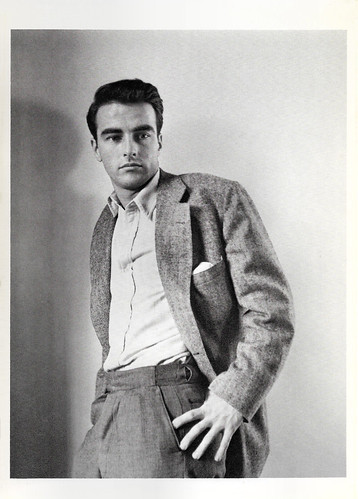
American postcard by Fotofolio, no. P43, 1978. Photo: Bob Landry / Life. Caption. Montgomery Clift, 1948.
Handsome American actor Montgomery Clift (1920-1966) was one of Hollywood's first Method actors. He starred in films like the Western Red River (Howard Hawks, 1948), A Place in the Sun (George Stevens, 1951), From Here To Eternity (Fred Zinnemann, 1953) and Suddenly, Last Summer (Joseph L. Mankiewicz, 1959), in which he co-starred for the third time with Elizabeth Taylor. A near-fatal auto accident in 1957 changed his looks and sent him into a drug and alcohol addiction. Clift died in 1966.
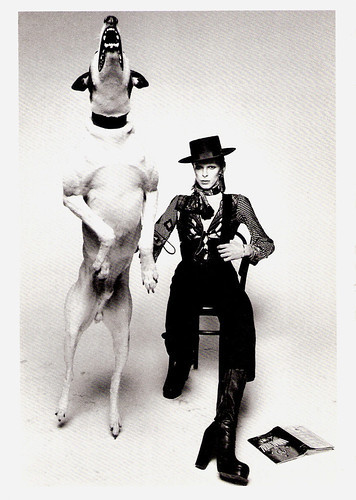
American postcard by Fotofolio, New York, no. P 254. Photo: Terry O'Neill, 1975.
English musician and actor David Bowie (1947-2016) was a major pop star for over four decades. Particularly during the 1970s, he was an influential innovator. He also earned acclaim with various stage and film roles.

American postcard by Fotofolio, New York, no. P 255. Photo: Terry O'Neill / Hamiltons Gallery, London. Caption: Mae West, Hollywood, 1970. Publicity still for Myra Breckinridge (Michael Sarne, 1970).
Blonde Mae West (1895-1982) was a seductive, overdressed, endearing, intelligent, and sometimes vulgar American actress and sex symbol. She featured a come-hither voice, aggressive sexuality, and a genius for comedy. West started in Vaudeville and on the stage in New York, and later moved to Hollywood to star in such films as I’m No Angel (1933), She Done Him Wrong (1933), and Klondike Annie (1936). She was one of the first women in the cinema to consistently write the films she starred in.
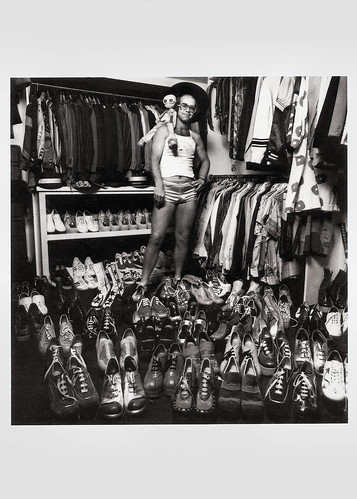
American card by Fotofolio, New York, no. P 287. Photo: Terry O'Neill, 1975.
Elton John (1947) is an English singer-songwriter, composer, pianist, record producer, and occasional actor. He has worked with lyricist Bernie Taupin as his songwriter partner since 1967; they have collaborated on more than 30 albums to date. In his five-decade career, Sir Elton Hercules John CBE had more than fifty Top 40 hits and has sold more than 300 million records, making him one of the best-selling music artists in the world.
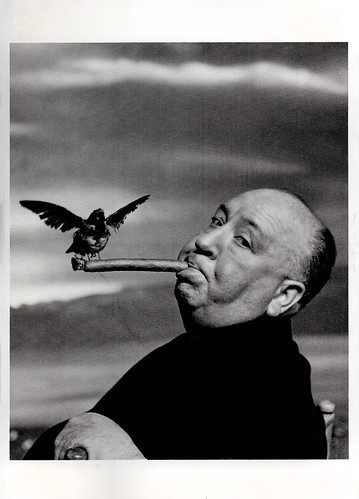
American postcard by Fotofolio, New York, no. PH 18, 1981. Photo: Philippe Halsman, 1962 / Hastings Galleries Collection. Alfred Hitchcock at the set of The Birds (1963).
British director Alfred Hitchcock (1899-1980) was known as 'The Master of Suspense'. He is one of the most influential and extensively studied filmmakers in the history of cinema. He had his first major success with The Lodger (1926), a silent thriller loosely based on Jack the Ripper. Hitchcock came to international attention with The Man Who Knew Too Much (1934), The 39 Steps (1935), and, most notably, The Lady Vanishes (1938). His first Hollywood film was the multi-Oscar-winning psychological thriller Rebecca (1940). Many classics followed including Spellbound (1945), Notorious (1946), Rear Window (1954), North by Northwest (1959) and The Birds (1963). In a career spanning six decades, he directed over 50 feature films which garnered a total of 46 Oscar nominations and 6 wins.
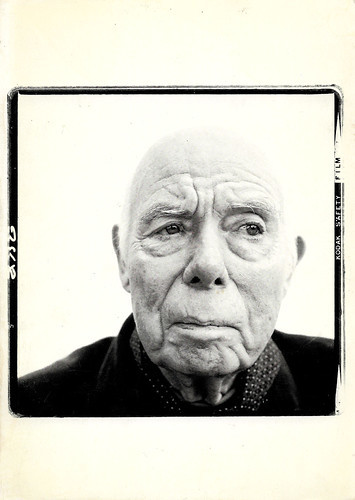
American postcard by Fotofolio, New York, no. RA24. Photo: Richard Avedon, 1972. Caption: Jean Renoir, Director, Beverly Hills, California, 4-11-72.
Jean Renoir (1894-1979) was one of the major French film directors before WW II. His films La Grande Illusion/The Great Illusion (1937) and La Règle du Jeu/The Rules of the Game (1939) belong to the masterpieces of French cinema. During the German invasion of France in 1941, he moved to Hollywood where he directed This Land Is Mine (1943), and The Southerner (1945). He later became an American citizen.
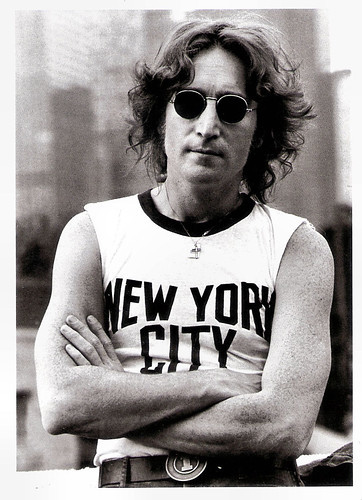
British postcard by Fotofolio, New York, no. M 12. Photo: Bob Gruen. Caption: New York City, 1974.
English musician, singer, and songwriter John Lennon (1940-1980) rose to worldwide fame with The Beatles, the most commercially successful band in the history of pop. With Paul McCartney, he formed a songwriting partnership that is one of the most celebrated of the 20th century. When the group disbanded in 1970, Lennon embarked on a solo career that produced the critically acclaimed albums 'John Lennon/Plastic Ono Band' and 'Imagine'.
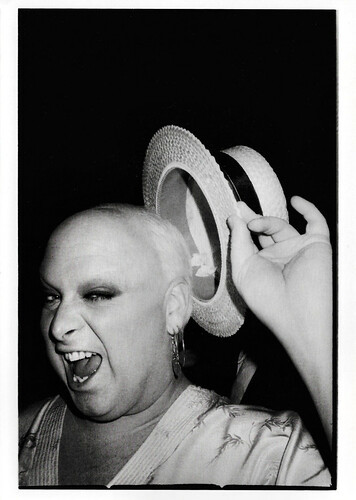
American postcard by Portfolio, New York, no. P 402. Photo: Christopher Makos. Caption: Divine, 1978.
Harris Glenn Milstead, better known by his stage name Divine (1945-1988), was an American actor, singer, and drag queen. He was closely associated with the independent filmmaker John Waters. Divine became the international icon of bad taste cinema.
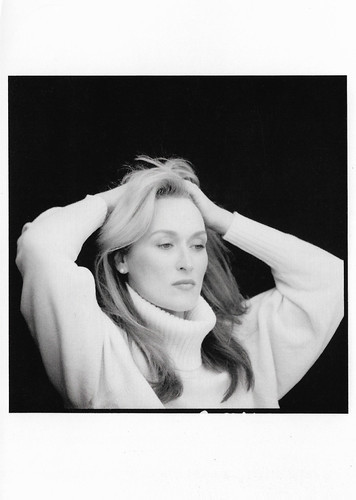
American postcard by Fotofolio, New York, no. P 432. Photo: Brigitte Lacombe, 1988.
American actress Meryl Streep (1949) is one of the best actresses of her generation, known for her versatility and accents. She has been nominated for the Oscar an astonishing 21 times and has won it three times. Among her other accolades, she has received 32 Golden Globe nominations, more than any other person, and won eight.
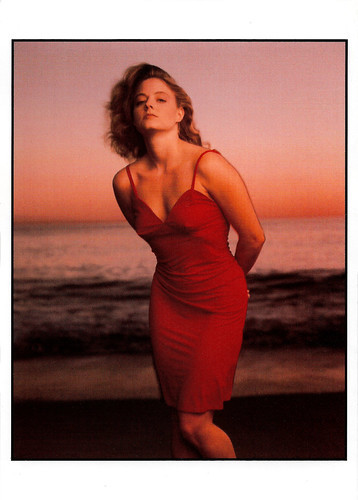
American postcard by Fotofolio, New York, no. Z 325. Photo: Annie Leibovitz. Caption: Jodie Foster, Malibu, California, 1988. Proceeds from the sale of this card donated to AIDS organisations.
American actress, director, and producer Jodie Foster (1962) has received two Academy Awards, three British Academy Film Awards, two Golden Globe Awards, a Screen Actors Guild Award and the Cecil B DeMille Award. A child prodigy, Foster began her professional career at the age of 3. Foster's breakthrough came at 14 with Martin Scorsese's psychological thriller Taxi Driver (1976). She played a child prostitute, for which she received an Oscar nomination. As an adult, she won new acclaim with The Accused (1988), The Silence of the Lambs (1991), and Nell (1994). She later starred in four thrillers, Panic Room (2002), Flightplan (2005), Inside Man (2006), and The Brave One (2007), which were commercially successful and well-received by critics. She has focused on directing in the 2010s.
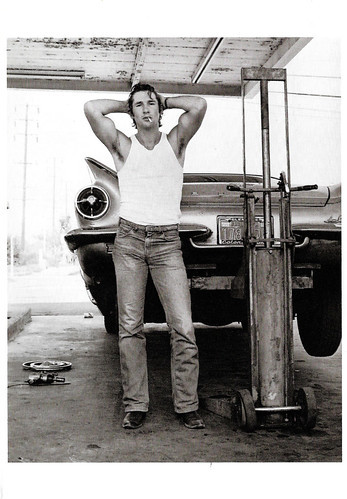
American postcard by Fotofolio, New York, no. HR 9. Photo: Herb Ritts. Caption: Richard Gere, San Bernardino, 1979. Courtesy Fahey / Klein Gallery Los Angeles. Proceeds of the sale of this card benefit The American Foundation For Aids Research.
American actor Richard Gere (1949) has been hailed as "The Sexiest Man alive" and a humanitarian, but he is foremost a good actor. He shone in such box office hits as American Gigolo (1980), An Officer and a Gentleman (1982), and Pretty Woman (1990). For portraying Billy Flynn in the Academy Award-winning musical Chicago (2002), he won a Golden Globe Award and a Screen Actors Guild Award as part of the cast.
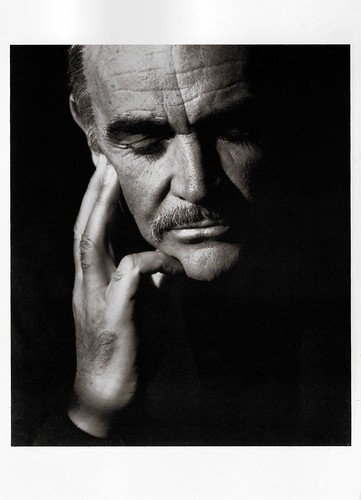
American postcard by Fotofolio, New York, no. HR 62. Photo: Herb Ritts. Caption: Sean Connery, Hollywood, 1989.
Scottish superstar Sean Connery (1930-2020) is best known as the original secret agent 007, starring in seven James Bond films between 1962 and 1983. His film career also included such notable films as Marnie (1964), The Name of the Rose (1986), The Untouchables (1987), and Indiana Jones and the Last Crusade (1989). Connery won an Academy Award, a Golden Globe, and also a BAFTA Award.
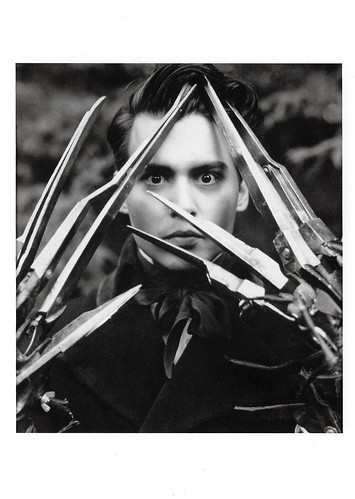
American postcard by Fotofolio, no. F 829. Photo: Herb Ritts. Johnny Depp in Edward Scissorhands (Tim Burton, 1990).
American actor Johnny Depp is one of the most versatile actors in today's Hollywood. He made his film debut as one of Freddy Krueger's victims in A Nightmare on Elm Street (1984). With his dark, intense eyes and highly defined cheekbones, he shot to fame as a teen idol in the TV series 21 Jump Street (1987). He is now best known for his many wonderful collaborations with director Tim Burton, and for his flamboyant pirate Jack Sparrow in the Pirates of Caribbean franchise. He likes to play freakishly eccentric outcasts whose oddities are misunderstood by society. Depp has been nominated for three Oscars and has won the Golden Globe and Screen Actors Guild Awards for Best Actor.
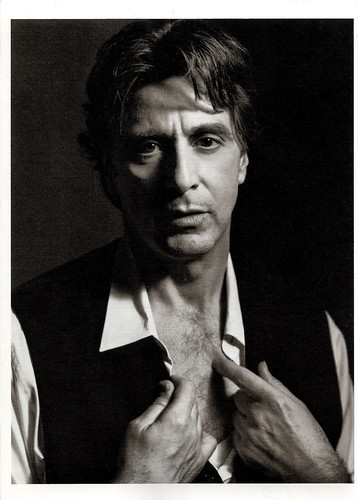
American postcard by Fotofolio, New York, no. HR 73. Photo: Herb Ritts. Caption: Al Pacino, New York City, 1992.
During the 1970s, American actor Al Pacino (1940) established himself with such films as The Godfather (1972), Serpico (1973), The Godfather: Part II (1974), and Dog Day Afternoon (1975). In the following decades, he became an enduring icon of American cinema. He won the Triple Crown of Acting: an Oscar for Best Actor for Scent of a Woman (1992); a Tony for Best Supporting Actor in the play 'Does a Tiger Wear a Necktie?' (1969) and for Best Actor in the play 'The Basic Training of Pavlo Hummel' (1977); and an Emmy for Best Actor in the Miniseries Angels in America (2003).
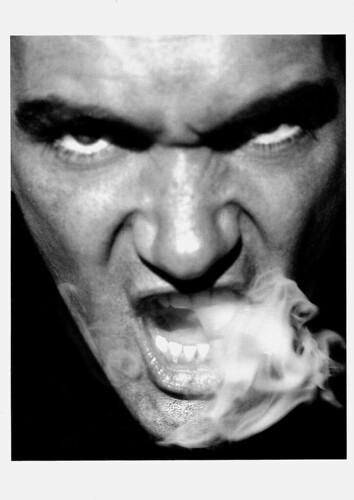
American postcard by Fotofolio, New York, no. F 429. Photo: Herb Ritts. Caption: Antonio Banderas, Malibu, 1994.
Charismatic Spanish film actor, film director, film producer and singer Antonio Banderas (1960) began his acting career at age 19 with a series of films by director Pedro Almodóvar. He became an internationally known Latin heartthrob with high-profile Hollywood films including Philadelphia (1993), Interview with the Vampire (1994), Desperado (1995), Evita (1996), The Mask of Zorro (1998), and the Shrek sequels.
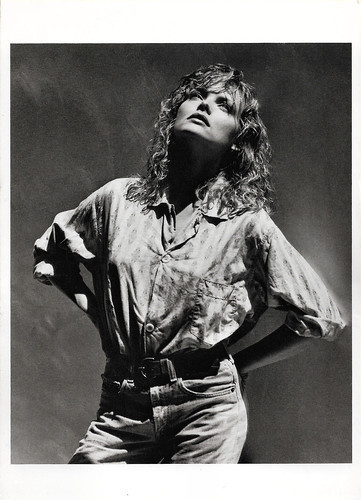
American postcard by Fotofolio, New York, no. GG 16. Photo: Greg Gorman. Caption: Michelle Pfeiffer, Los Angeles, 1988. Proceeds from the sale of this card benefit the American Foundation for AIDS Research
American actress and producer Michelle Pfeiffer (1958) was one of the most popular and talented Hollywood actresses of the 1980s and 1990s. Noted for her versatility as a character actress, Pfeiffer has become particularly known for portraying nuanced and unglamorous, emotionally distant women as well as strong female characters with intense sex appeal.

American postcard by Fotofolio, New York, N.Y., no. JC13. Photo: John Chan, 1988.
Blonde and blue-eyed American actress Uma Thurman (1970) is best known for her roles in Quentin Tarantino's Pulp Fiction (1994), Kill Bill: Vol. 1 (2003) and Kill Bill: Vol. 2 (2004) and was hailed as Tarantino's muse. Furthermore, she starred in a wide variety of films, from romantic comedies and dramas to science fiction and action films.
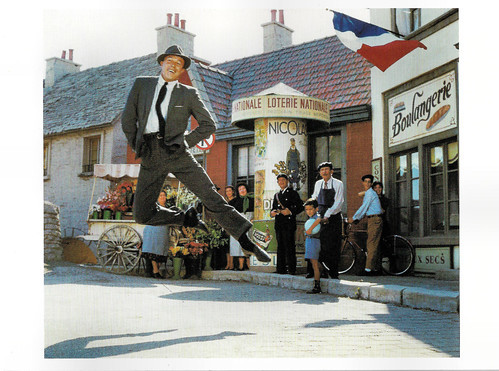
American postcard by Fotofolio, no. 2859. Photo: Milton H. Greene. Caption: Gene Kelly, Los Angeles, 1959.
Source: Fotofolio.

American postcard by Fotofolio, no. P43, 1978. Photo: Bob Landry / Life. Caption. Montgomery Clift, 1948.
Handsome American actor Montgomery Clift (1920-1966) was one of Hollywood's first Method actors. He starred in films like the Western Red River (Howard Hawks, 1948), A Place in the Sun (George Stevens, 1951), From Here To Eternity (Fred Zinnemann, 1953) and Suddenly, Last Summer (Joseph L. Mankiewicz, 1959), in which he co-starred for the third time with Elizabeth Taylor. A near-fatal auto accident in 1957 changed his looks and sent him into a drug and alcohol addiction. Clift died in 1966.

American postcard by Fotofolio, New York, no. P 254. Photo: Terry O'Neill, 1975.
English musician and actor David Bowie (1947-2016) was a major pop star for over four decades. Particularly during the 1970s, he was an influential innovator. He also earned acclaim with various stage and film roles.

American postcard by Fotofolio, New York, no. P 255. Photo: Terry O'Neill / Hamiltons Gallery, London. Caption: Mae West, Hollywood, 1970. Publicity still for Myra Breckinridge (Michael Sarne, 1970).
Blonde Mae West (1895-1982) was a seductive, overdressed, endearing, intelligent, and sometimes vulgar American actress and sex symbol. She featured a come-hither voice, aggressive sexuality, and a genius for comedy. West started in Vaudeville and on the stage in New York, and later moved to Hollywood to star in such films as I’m No Angel (1933), She Done Him Wrong (1933), and Klondike Annie (1936). She was one of the first women in the cinema to consistently write the films she starred in.

American card by Fotofolio, New York, no. P 287. Photo: Terry O'Neill, 1975.
Elton John (1947) is an English singer-songwriter, composer, pianist, record producer, and occasional actor. He has worked with lyricist Bernie Taupin as his songwriter partner since 1967; they have collaborated on more than 30 albums to date. In his five-decade career, Sir Elton Hercules John CBE had more than fifty Top 40 hits and has sold more than 300 million records, making him one of the best-selling music artists in the world.

American postcard by Fotofolio, New York, no. PH 18, 1981. Photo: Philippe Halsman, 1962 / Hastings Galleries Collection. Alfred Hitchcock at the set of The Birds (1963).
British director Alfred Hitchcock (1899-1980) was known as 'The Master of Suspense'. He is one of the most influential and extensively studied filmmakers in the history of cinema. He had his first major success with The Lodger (1926), a silent thriller loosely based on Jack the Ripper. Hitchcock came to international attention with The Man Who Knew Too Much (1934), The 39 Steps (1935), and, most notably, The Lady Vanishes (1938). His first Hollywood film was the multi-Oscar-winning psychological thriller Rebecca (1940). Many classics followed including Spellbound (1945), Notorious (1946), Rear Window (1954), North by Northwest (1959) and The Birds (1963). In a career spanning six decades, he directed over 50 feature films which garnered a total of 46 Oscar nominations and 6 wins.

American postcard by Fotofolio, New York, no. RA24. Photo: Richard Avedon, 1972. Caption: Jean Renoir, Director, Beverly Hills, California, 4-11-72.
Jean Renoir (1894-1979) was one of the major French film directors before WW II. His films La Grande Illusion/The Great Illusion (1937) and La Règle du Jeu/The Rules of the Game (1939) belong to the masterpieces of French cinema. During the German invasion of France in 1941, he moved to Hollywood where he directed This Land Is Mine (1943), and The Southerner (1945). He later became an American citizen.

British postcard by Fotofolio, New York, no. M 12. Photo: Bob Gruen. Caption: New York City, 1974.
English musician, singer, and songwriter John Lennon (1940-1980) rose to worldwide fame with The Beatles, the most commercially successful band in the history of pop. With Paul McCartney, he formed a songwriting partnership that is one of the most celebrated of the 20th century. When the group disbanded in 1970, Lennon embarked on a solo career that produced the critically acclaimed albums 'John Lennon/Plastic Ono Band' and 'Imagine'.

American postcard by Portfolio, New York, no. P 402. Photo: Christopher Makos. Caption: Divine, 1978.
Harris Glenn Milstead, better known by his stage name Divine (1945-1988), was an American actor, singer, and drag queen. He was closely associated with the independent filmmaker John Waters. Divine became the international icon of bad taste cinema.

American postcard by Fotofolio, New York, no. P 432. Photo: Brigitte Lacombe, 1988.
American actress Meryl Streep (1949) is one of the best actresses of her generation, known for her versatility and accents. She has been nominated for the Oscar an astonishing 21 times and has won it three times. Among her other accolades, she has received 32 Golden Globe nominations, more than any other person, and won eight.

American postcard by Fotofolio, New York, no. Z 325. Photo: Annie Leibovitz. Caption: Jodie Foster, Malibu, California, 1988. Proceeds from the sale of this card donated to AIDS organisations.
American actress, director, and producer Jodie Foster (1962) has received two Academy Awards, three British Academy Film Awards, two Golden Globe Awards, a Screen Actors Guild Award and the Cecil B DeMille Award. A child prodigy, Foster began her professional career at the age of 3. Foster's breakthrough came at 14 with Martin Scorsese's psychological thriller Taxi Driver (1976). She played a child prostitute, for which she received an Oscar nomination. As an adult, she won new acclaim with The Accused (1988), The Silence of the Lambs (1991), and Nell (1994). She later starred in four thrillers, Panic Room (2002), Flightplan (2005), Inside Man (2006), and The Brave One (2007), which were commercially successful and well-received by critics. She has focused on directing in the 2010s.

American postcard by Fotofolio, New York, no. HR 9. Photo: Herb Ritts. Caption: Richard Gere, San Bernardino, 1979. Courtesy Fahey / Klein Gallery Los Angeles. Proceeds of the sale of this card benefit The American Foundation For Aids Research.
American actor Richard Gere (1949) has been hailed as "The Sexiest Man alive" and a humanitarian, but he is foremost a good actor. He shone in such box office hits as American Gigolo (1980), An Officer and a Gentleman (1982), and Pretty Woman (1990). For portraying Billy Flynn in the Academy Award-winning musical Chicago (2002), he won a Golden Globe Award and a Screen Actors Guild Award as part of the cast.

American postcard by Fotofolio, New York, no. HR 62. Photo: Herb Ritts. Caption: Sean Connery, Hollywood, 1989.
Scottish superstar Sean Connery (1930-2020) is best known as the original secret agent 007, starring in seven James Bond films between 1962 and 1983. His film career also included such notable films as Marnie (1964), The Name of the Rose (1986), The Untouchables (1987), and Indiana Jones and the Last Crusade (1989). Connery won an Academy Award, a Golden Globe, and also a BAFTA Award.

American postcard by Fotofolio, no. F 829. Photo: Herb Ritts. Johnny Depp in Edward Scissorhands (Tim Burton, 1990).
American actor Johnny Depp is one of the most versatile actors in today's Hollywood. He made his film debut as one of Freddy Krueger's victims in A Nightmare on Elm Street (1984). With his dark, intense eyes and highly defined cheekbones, he shot to fame as a teen idol in the TV series 21 Jump Street (1987). He is now best known for his many wonderful collaborations with director Tim Burton, and for his flamboyant pirate Jack Sparrow in the Pirates of Caribbean franchise. He likes to play freakishly eccentric outcasts whose oddities are misunderstood by society. Depp has been nominated for three Oscars and has won the Golden Globe and Screen Actors Guild Awards for Best Actor.

American postcard by Fotofolio, New York, no. HR 73. Photo: Herb Ritts. Caption: Al Pacino, New York City, 1992.
During the 1970s, American actor Al Pacino (1940) established himself with such films as The Godfather (1972), Serpico (1973), The Godfather: Part II (1974), and Dog Day Afternoon (1975). In the following decades, he became an enduring icon of American cinema. He won the Triple Crown of Acting: an Oscar for Best Actor for Scent of a Woman (1992); a Tony for Best Supporting Actor in the play 'Does a Tiger Wear a Necktie?' (1969) and for Best Actor in the play 'The Basic Training of Pavlo Hummel' (1977); and an Emmy for Best Actor in the Miniseries Angels in America (2003).

American postcard by Fotofolio, New York, no. F 429. Photo: Herb Ritts. Caption: Antonio Banderas, Malibu, 1994.
Charismatic Spanish film actor, film director, film producer and singer Antonio Banderas (1960) began his acting career at age 19 with a series of films by director Pedro Almodóvar. He became an internationally known Latin heartthrob with high-profile Hollywood films including Philadelphia (1993), Interview with the Vampire (1994), Desperado (1995), Evita (1996), The Mask of Zorro (1998), and the Shrek sequels.

American postcard by Fotofolio, New York, no. GG 16. Photo: Greg Gorman. Caption: Michelle Pfeiffer, Los Angeles, 1988. Proceeds from the sale of this card benefit the American Foundation for AIDS Research
American actress and producer Michelle Pfeiffer (1958) was one of the most popular and talented Hollywood actresses of the 1980s and 1990s. Noted for her versatility as a character actress, Pfeiffer has become particularly known for portraying nuanced and unglamorous, emotionally distant women as well as strong female characters with intense sex appeal.

American postcard by Fotofolio, New York, N.Y., no. JC13. Photo: John Chan, 1988.
Blonde and blue-eyed American actress Uma Thurman (1970) is best known for her roles in Quentin Tarantino's Pulp Fiction (1994), Kill Bill: Vol. 1 (2003) and Kill Bill: Vol. 2 (2004) and was hailed as Tarantino's muse. Furthermore, she starred in a wide variety of films, from romantic comedies and dramas to science fiction and action films.

American postcard by Fotofolio, no. 2859. Photo: Milton H. Greene. Caption: Gene Kelly, Los Angeles, 1959.
Source: Fotofolio.
Published on April 16, 2021 22:00
April 15, 2021
Mari Törőcsik (1935-2021)
At the age of 85, Hungarian actress Mari Törőcsik (1935) passed away on 16 April 2021. Ever since her first film appearance, she was the leading star of the Hungarian cinema. The sensitive and intelligent actress played a great diversity of roles both on stage and for the camera. During her long career she appeared in more than 120 films and TV films.
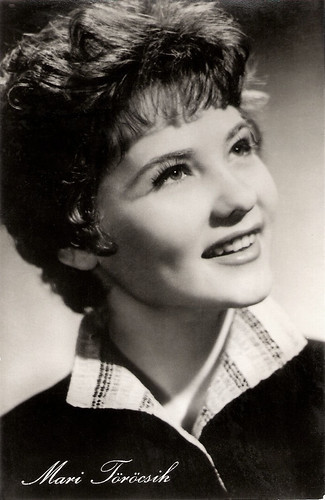
East-German starcard by VEB Progress Film-Vertrieb, Berlin, no. 805. Retail price: 0,20 DM. Photo: Progress / Tibor Inkey.
A superbly refined screen presence
Mari Törőcsik (or Törőczik) was born in Pely, Hungary, in 1935. She graduated in 1957 after which she went to work for the National Theatre.
Her first role was Solveig in 'Peer Gynt'. She would stay with the National Theatre for 25 years.
She studied with leading Hungarian director Zoltán Fábri who cast her in his famous film, Körhinta/Merry-Go-Round (1955), which brought Mari Törőcsik immediate international recognition at the Cannes Film Festival that year. The story concerns a young village couple (Mari and Bela Barsi) who date at a traditional country fair.
Hal Erickson at AllMovie : “As they dance the night away, the boy expresses his love for the girl, resulting in a startling reaction. The film is unabashedly sentimental, but the performances of the two leads transcend the storyline's goofier passages.”
Dina Iordanova writes at Senses of Cinema : “A breakthrough indictment of patriarchy, Körhinta was among the first films that explored the tensions between patriarchy and the socialist rush for collectivisation of agriculture” and she describes Töröcsik as “Seemingly plain by appearance, she has a superbly refined screen presence“.
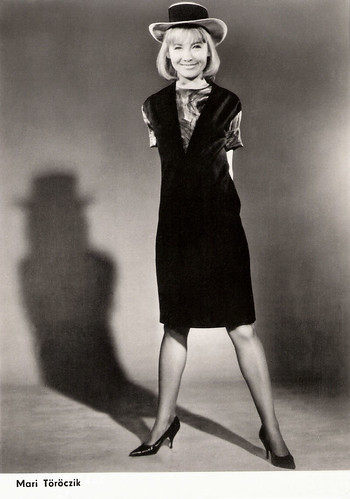
East-German postcard by VEB Progress Film-Vertrieb, Berlin, no. 2427, 1965. Retail price: 0,20 MDN. Photo: Hungariafilm.
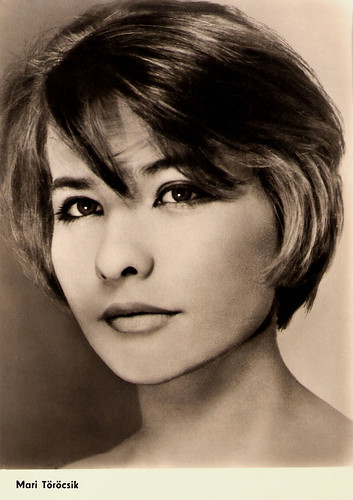
East-German postcard by VEB Progress Film-Vertrieb, Berlin, no. 1482, 1961. Retail price: 0,20 DM.
Hungarian New Cinema
Mari Törőcsik's first screen role in Körhinta/Merry-Go-Round (1955) would have a determining effect on her whole career.
She starred in more films of the Hungarian New Cinema, like Édes Anna (Zoltan Fabri, 1959), Ket Vallomas/Two Wishes (Márton Keleti, 1957), and the romantic drama Vasvirag/Iron Flower (János Herskó, 198) which were also presented at the Cannes Film Festival.
Other successes were Szent Péter esernyöje/St. Peter’s Umbrella (Frigyes Bán, Vladislav Pavlovic, 1958) and Álmatlan évek/Sleepless Years (Félix Máriássy, 1959) with Éva Ruttkay .
In 1960 Mari won the Prize for Best Actress at the Karlovy Vary International Film Festival in the Czech Republic for Kölyök (Mihály Szemes, Miklós Markos, 1959).
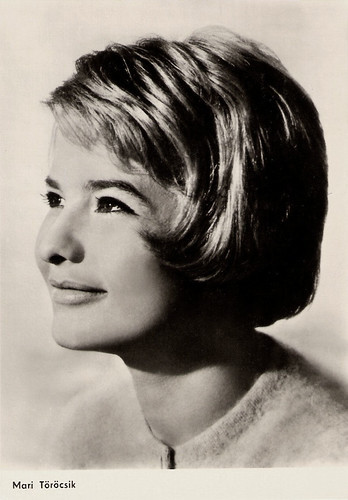
East-German postcard by VEB Progress Film-Vertrieb, Berlin, no. 2945, 1967. Retail price: 0,20 MDN. Photo: Progress.
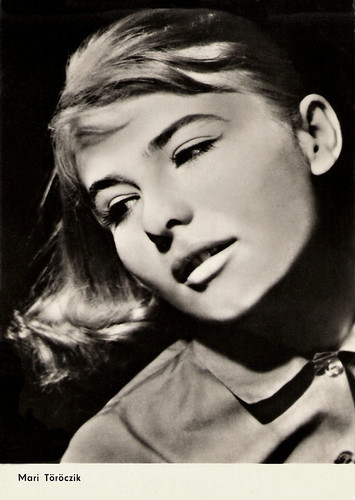
East-German postcard by VEB Progress Film-Vertrieb, Berlin, no. 2036, 1965. Retail price: 0,20 MDN.
Cannes Film Festival
In the 1960s, Mari Törőcsik was ‘discovered’ by a new generation of directors. Miklos Jancsó gave her a leading role in his political drama Csend és kiáltás/Silence and Cry (1967), and later in Szerelmem, Elektra/Electra, My Love (1974), a drama based on the Greek myth.
In 1968, she also worked with Márta Mészáros on Holdudvar/Binding Sentiments (1968), and with Jerzy Skolimowski on the melodrama Párbeszéd/Dialogue (Jerzy Skolimowski, János Herskó, 1963).
Töröcsik won twice an award at the Cannes Film Festival. In 1971 she shared the Special Mention to the film's lead actresses for Szerelem/Love (Károly Makk, 1971) with Lili Darvas who played the old woman in the film. This tender drama deals with two women in the 1950s, the wife and old mother of a soldier who are forced to spend a lot of time together. While they love each other, they also act out their personal neuroses on the other.
Her next cooperation with Károly Makk, Macskajatek/Catsplay (1972) was nominated for the 1974 Oscar for Best Foreign Film. Earlier, A pál-utcai fiúk/The Boys of Paul Street (Zoltán Fábri, 1969) also had been nominated for an Oscar.
In 1976 Mari won the Best Actress award in Cannes for Déryne, hol van?/Mrs. Déry, Where Are You? (Gyula Maá, 1976). That year, she tied the prize with Dominique Sanda for L'eredità Ferramonti/The Inheritance (1976). In 1983, she received a special award at Cannes for her whole career.
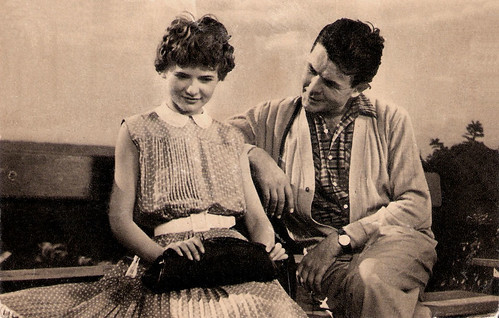
Hungarian postcard by Képzömövészeti Alap (SZ), Budapest, 11/583, 1965. Retail price: Ára 0,60 fillé. Mari Töröcsik and Elemér Tarsoiy in Két vallomás/Two Confessions (Márton Keleti, 1962).
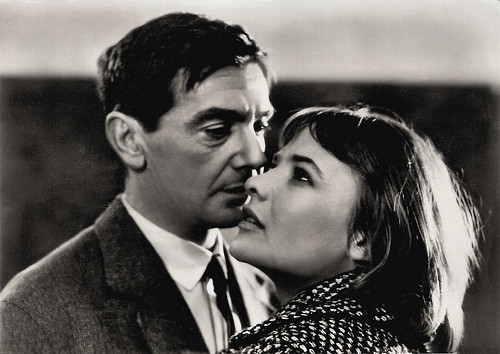
East-German postcard by VEB Progress Film-Vertrieb, Berlin, no. 2.303, 1965. Retail price: 0,20 MDN. Photo: Progress. Mari Töröcsik and Miklos Gabor.
International Productions
In the 1980s, another generation of filmmakers started to work with Mari Törőcsik. Every second year, she played a role in the film of the best graduating student at the Film School. She had memorable leads in Pál Sándor's Szerencsés Dániel/Daniel Takes a Train (1983) and in Attila Janisch's Hosszú alkony/Long Twilight (1997).
She was the choice for crucial secondary parts in Napló apámnak, anyámnak/Diary for My Father and Mother (Márta Mészáros, 1990), and Szamárköhögés/Whooping Cough (Péter Gárdos, 1986), a sensitive exploration of the failed Hungarian 1956 anti-communist revolution.
She also incidentally appeared in international productions, such as The Music Box (Costa-Gavras, 1990) with Jessica Lange, Mio caro dottor Grasler/The Bachelor (Roberto Faenza, 1991) starring Keith Carradine, Le Violon De Rothschild/Rotschild’s Violin (Edgardo Cozarinsky, 1997) and Sunshine (István Szabó, 2000) starring Ralph Fiennes.
More recent films in which she played were Telitalálat/Winning Ticket (Sandor Kardos, 2003), Egy Het Pesten Es Budan/A Long Weekend in Pest and Buda (Károly Makk, 2003) for which she was reunited with Lili Darvas, and Eszter Hagyateka/Eszter's Inheritance (Jozsef Sipos, 2008) with Eszter Nagy-Kálózy.
In her home country, Mari Törőcsik was awarded the Kossuth Prize twice, in 1973 and 1999. Mari Töröcsik has been married twice, first she married actor Gyula Bodrogi, and from 1973 on she was married to film director Gyula Maár, with whom she has a child.
She was cast by Maár in a number of female roles focusing on mid-life crisis, like Végül/At the End of the Road (1973), Déryné hol van?/Mrs. Déry, Where Are You? (1975) and Teketória/Flare and Flicker (1976), as well as in Hoppá/Whoops (1993).
Mari Törőcsik’s Cannes experiences are recounted in Gyula Maár's documentary Töröcsik Mari Cannes-ban (1997). Finally, she appeared in the romantic drama Kaland/Adventure (József Sipos, 2011) and she played the lead in the TV film Ideje az öregségnek/It's time for an old phenomenon (Emil Novák, 2011).
On 16 April 2021, Mari Törőcsik passed away in Szombathely. She was 85.
Scene from Körhinta/Merry-Go-Round (1955).
Mari Törőcsik sings Csak a szépre emlékezem. Source: Kovezett (YouTube).
Sources: Hal Erickson (AllMovie), Dina Iordanova (Senses of Cinema), Graham Petrie (Kinoeye), (IMDb), Wikipedia, and .

East-German starcard by VEB Progress Film-Vertrieb, Berlin, no. 805. Retail price: 0,20 DM. Photo: Progress / Tibor Inkey.
A superbly refined screen presence
Mari Törőcsik (or Törőczik) was born in Pely, Hungary, in 1935. She graduated in 1957 after which she went to work for the National Theatre.
Her first role was Solveig in 'Peer Gynt'. She would stay with the National Theatre for 25 years.
She studied with leading Hungarian director Zoltán Fábri who cast her in his famous film, Körhinta/Merry-Go-Round (1955), which brought Mari Törőcsik immediate international recognition at the Cannes Film Festival that year. The story concerns a young village couple (Mari and Bela Barsi) who date at a traditional country fair.
Hal Erickson at AllMovie : “As they dance the night away, the boy expresses his love for the girl, resulting in a startling reaction. The film is unabashedly sentimental, but the performances of the two leads transcend the storyline's goofier passages.”
Dina Iordanova writes at Senses of Cinema : “A breakthrough indictment of patriarchy, Körhinta was among the first films that explored the tensions between patriarchy and the socialist rush for collectivisation of agriculture” and she describes Töröcsik as “Seemingly plain by appearance, she has a superbly refined screen presence“.

East-German postcard by VEB Progress Film-Vertrieb, Berlin, no. 2427, 1965. Retail price: 0,20 MDN. Photo: Hungariafilm.

East-German postcard by VEB Progress Film-Vertrieb, Berlin, no. 1482, 1961. Retail price: 0,20 DM.
Hungarian New Cinema
Mari Törőcsik's first screen role in Körhinta/Merry-Go-Round (1955) would have a determining effect on her whole career.
She starred in more films of the Hungarian New Cinema, like Édes Anna (Zoltan Fabri, 1959), Ket Vallomas/Two Wishes (Márton Keleti, 1957), and the romantic drama Vasvirag/Iron Flower (János Herskó, 198) which were also presented at the Cannes Film Festival.
Other successes were Szent Péter esernyöje/St. Peter’s Umbrella (Frigyes Bán, Vladislav Pavlovic, 1958) and Álmatlan évek/Sleepless Years (Félix Máriássy, 1959) with Éva Ruttkay .
In 1960 Mari won the Prize for Best Actress at the Karlovy Vary International Film Festival in the Czech Republic for Kölyök (Mihály Szemes, Miklós Markos, 1959).

East-German postcard by VEB Progress Film-Vertrieb, Berlin, no. 2945, 1967. Retail price: 0,20 MDN. Photo: Progress.

East-German postcard by VEB Progress Film-Vertrieb, Berlin, no. 2036, 1965. Retail price: 0,20 MDN.
Cannes Film Festival
In the 1960s, Mari Törőcsik was ‘discovered’ by a new generation of directors. Miklos Jancsó gave her a leading role in his political drama Csend és kiáltás/Silence and Cry (1967), and later in Szerelmem, Elektra/Electra, My Love (1974), a drama based on the Greek myth.
In 1968, she also worked with Márta Mészáros on Holdudvar/Binding Sentiments (1968), and with Jerzy Skolimowski on the melodrama Párbeszéd/Dialogue (Jerzy Skolimowski, János Herskó, 1963).
Töröcsik won twice an award at the Cannes Film Festival. In 1971 she shared the Special Mention to the film's lead actresses for Szerelem/Love (Károly Makk, 1971) with Lili Darvas who played the old woman in the film. This tender drama deals with two women in the 1950s, the wife and old mother of a soldier who are forced to spend a lot of time together. While they love each other, they also act out their personal neuroses on the other.
Her next cooperation with Károly Makk, Macskajatek/Catsplay (1972) was nominated for the 1974 Oscar for Best Foreign Film. Earlier, A pál-utcai fiúk/The Boys of Paul Street (Zoltán Fábri, 1969) also had been nominated for an Oscar.
In 1976 Mari won the Best Actress award in Cannes for Déryne, hol van?/Mrs. Déry, Where Are You? (Gyula Maá, 1976). That year, she tied the prize with Dominique Sanda for L'eredità Ferramonti/The Inheritance (1976). In 1983, she received a special award at Cannes for her whole career.

Hungarian postcard by Képzömövészeti Alap (SZ), Budapest, 11/583, 1965. Retail price: Ára 0,60 fillé. Mari Töröcsik and Elemér Tarsoiy in Két vallomás/Two Confessions (Márton Keleti, 1962).

East-German postcard by VEB Progress Film-Vertrieb, Berlin, no. 2.303, 1965. Retail price: 0,20 MDN. Photo: Progress. Mari Töröcsik and Miklos Gabor.
International Productions
In the 1980s, another generation of filmmakers started to work with Mari Törőcsik. Every second year, she played a role in the film of the best graduating student at the Film School. She had memorable leads in Pál Sándor's Szerencsés Dániel/Daniel Takes a Train (1983) and in Attila Janisch's Hosszú alkony/Long Twilight (1997).
She was the choice for crucial secondary parts in Napló apámnak, anyámnak/Diary for My Father and Mother (Márta Mészáros, 1990), and Szamárköhögés/Whooping Cough (Péter Gárdos, 1986), a sensitive exploration of the failed Hungarian 1956 anti-communist revolution.
She also incidentally appeared in international productions, such as The Music Box (Costa-Gavras, 1990) with Jessica Lange, Mio caro dottor Grasler/The Bachelor (Roberto Faenza, 1991) starring Keith Carradine, Le Violon De Rothschild/Rotschild’s Violin (Edgardo Cozarinsky, 1997) and Sunshine (István Szabó, 2000) starring Ralph Fiennes.
More recent films in which she played were Telitalálat/Winning Ticket (Sandor Kardos, 2003), Egy Het Pesten Es Budan/A Long Weekend in Pest and Buda (Károly Makk, 2003) for which she was reunited with Lili Darvas, and Eszter Hagyateka/Eszter's Inheritance (Jozsef Sipos, 2008) with Eszter Nagy-Kálózy.
In her home country, Mari Törőcsik was awarded the Kossuth Prize twice, in 1973 and 1999. Mari Töröcsik has been married twice, first she married actor Gyula Bodrogi, and from 1973 on she was married to film director Gyula Maár, with whom she has a child.
She was cast by Maár in a number of female roles focusing on mid-life crisis, like Végül/At the End of the Road (1973), Déryné hol van?/Mrs. Déry, Where Are You? (1975) and Teketória/Flare and Flicker (1976), as well as in Hoppá/Whoops (1993).
Mari Törőcsik’s Cannes experiences are recounted in Gyula Maár's documentary Töröcsik Mari Cannes-ban (1997). Finally, she appeared in the romantic drama Kaland/Adventure (József Sipos, 2011) and she played the lead in the TV film Ideje az öregségnek/It's time for an old phenomenon (Emil Novák, 2011).
On 16 April 2021, Mari Törőcsik passed away in Szombathely. She was 85.
Scene from Körhinta/Merry-Go-Round (1955).
Mari Törőcsik sings Csak a szépre emlékezem. Source: Kovezett (YouTube).
Sources: Hal Erickson (AllMovie), Dina Iordanova (Senses of Cinema), Graham Petrie (Kinoeye), (IMDb), Wikipedia, and .
Published on April 15, 2021 22:00
Terry Moore
Terry Moore (1929) is an American film and television actress. She starred in several box-office hits including Mighty Joe Young (1949), Come Back, Little Sheba (1952) (for which she was nominated for an Academy Award for Best Supporting Actress), and Peyton Place (1957). In the 1970s she asserted that she was the secret wife of the late billionaire Howard Hughes, and received a settlement.
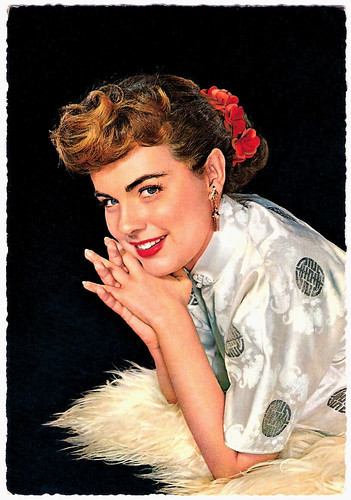
German postcard by Krüger, no 102/?.
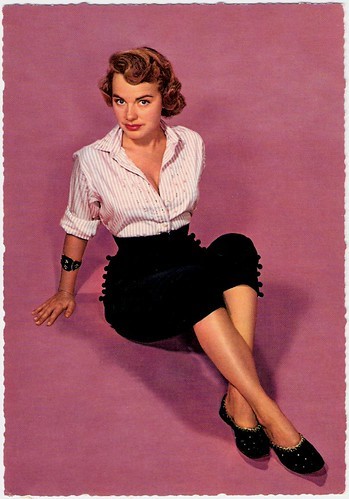
German postcard by Krüger, no. 902/5.
Hollywood's Sexy Tomboy
Terry Moore was born Helen Luella Koford in 1929, in Glendale, California. Moore grew up in a Mormon family in Los Angeles, California.
She worked as a child model before making her film debut at age 11 in Maryland (Henry King, 1940). She was billed as Judy Ford, Jan Ford, and January Ford before taking Terry Moore as her name in 1948.
Moore worked in radio in the 1940s, most memorably as Bumps Smith on 'The Smiths of Hollywood'. In the cinema, she starred in the box-office hit Mighty Joe Young (Ernest B. Schoedsack, 1949), made by the same creative team responsible for King Kong (Merian C. Cooper, Ernest B. Schoedsack, 1933).
Three years later, she was nominated for an Academy Award for Best Supporting Actress for the drama Come Back, Little Sheba (Daniel Mann, 1952), starring Burt Lancaster. In 1953, she appeared on the cover of Life magazine as "Hollywood's sexy tomboy".
During the 1950s, Moore worked steadily in films such as The Great Rupert (Irving Pichel, 1950), the Film Noir Two of a Kind (Henry Levin, 1951), the adventure film Beneath the 12-Mile Reef (Robert D. Webb, 1953) with Robert Wagner, Daddy Long Legs (Jean Negulesco, 1955) starring Leslie Caron , and Between Heaven and Hell (Richard Fleischer, 1956).
A huge box office hit was Peyton Place (Mark Robson, 1957) in which she appeared as Betty Anderson. She also appeared in the Pat Boone musical Bernardine (Henry Levin, 1957), A Private's Affair (Raoul Walsh, 1959) featuring Sal Mineo , and Why Must I Die? (Roy Del Ruth, 1960).
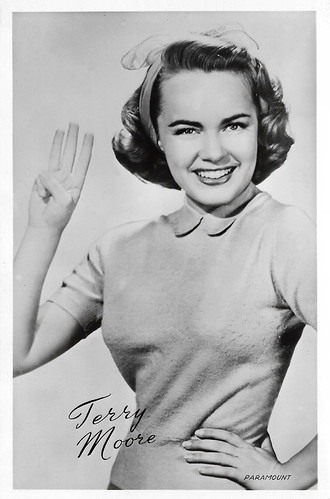
Dutch postcard by Takken / 't Sticht, no. 2001. Photo: Paramount.
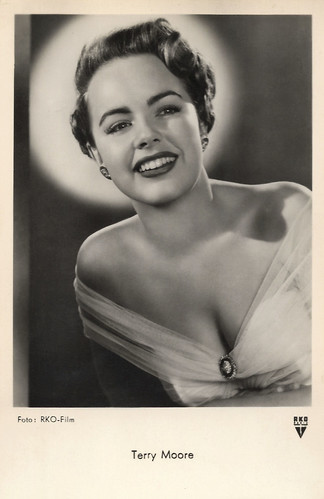
French postcard by Editions P.I., Paris, French license holder for Ufa, no. FK 1895. Photo: RKO-Film.

French postcard by Editions du Globe, no. 541. Photo: 20th Century Fox.
The Secret Wife of Howard Hughes
By the 1960s, Terry Moore's film career had faltered. Although she appeared less frequently in the cinema, she did make films such as Platinum High School (Charles Haas, 1960), the Westerns Black Spurs (R.G. Springsteen, 1965), Town Tamer (Lesley Selander, 1965), and Waco (R.G. Springsteen, 1966), and the Spy film A Man Called Dagger (Richard Rush, 1967).
Lacking film roles, Moore appeared on television. In 1962, she appeared as a rancher's daughter in the Western series Empire (1962-1963) opposite Ryan O'Neal and Charles Bronson . She also appeared in three episodes of Batman (1967) and on the interview program Here's Hollywood.
After the 1960s, Moore semiretired from acting. After the death of billionaire Howard Hughes, she claimed that the pair had secretly married on a yacht in international waters off the coast of Mexico in 1949 and never divorced. Despite the fact that Moore married two other men while she was still "married" to Hughes, his estate paid her an undisclosed settlement in 1984.
She only completed two B-films in the 1970s, The Daredevil (Robert W. Stringer, 1972) and the Martial Arts film Death Dimension (Al Adamson, 1978) starring Jim Kelly.
By the 1980s, her career had resumed with minor roles in such low-budgeted B-movies as the women in prison film Hellhole (Pierre de Moro, 1985) and the comedy Going Overboard (Valerie Breiman, 1989), starring Adam Sandler in his film debut. At age 55, Moore posed nude in the August 1984 issue of Playboy magazine, photographed by Ken Marcus. The pictorial included the cover, and the text emphasised her connection to Howard Hughes.
She returned in the remake of Mighty Joe Young (Ron Underwood, 1998), starring Bill Paxton and Charlize Theron. Since she was a pilot herself, Terry played a major role in preparing Leonardo DiCaprio for his portrayal of Howard Hughes in The Aviator (Martin Scorsese, 2004).
Her later films include the Swedish production Kill Your Darlings (Björne Larson, 2006) with Fares Fares, and father and son Stellan and Alexander Skarsgård. In 2014, she guest-starred in the role of Lilly Hill on the crime series True Detective, starring Matthew McConaughey.
Moore's first marriage, in 1951 to the American football player and Heisman Trophy winner Glenn Davis, lasted one year. A subsequent marriage to Eugene McGarth, in 1956, lasted three years. One year after this marriage ended, Moore married Stuart Cramer after his divorce from Jean Peters. One of the two children from this 13-year marriage is actor Grant Cramer. Following the dissolution of this marriage in 1972, Moore did not remarry for 20 years. Her 1992 marriage to Jerry Rivers lasted until his death in 2001. Terry Moore has a star on the Hollywood Walk of Fame at 7080 Hollywood Blvd.
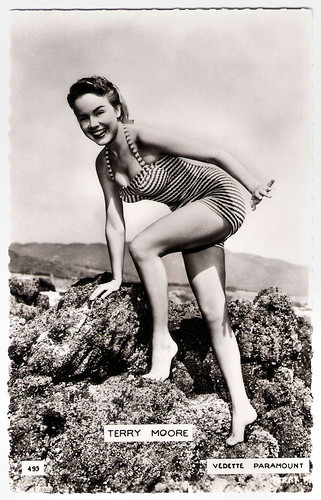
French postcard by Editions P.I., Paris, no 499, 1954. Photo: Paramount.
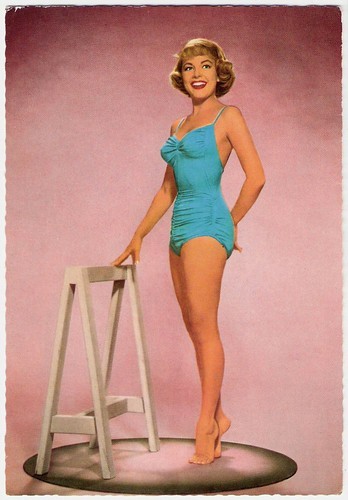
Dutch postcard by P. Moorlag, Heerlen, no. 4/6.
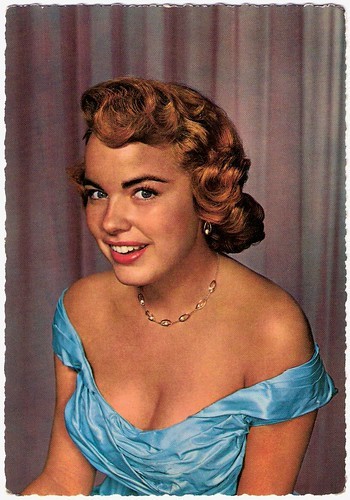
German postcard by Krüger, no. 902/3.
Sources: (IMDb), Wikipedia, and .

German postcard by Krüger, no 102/?.

German postcard by Krüger, no. 902/5.
Hollywood's Sexy Tomboy
Terry Moore was born Helen Luella Koford in 1929, in Glendale, California. Moore grew up in a Mormon family in Los Angeles, California.
She worked as a child model before making her film debut at age 11 in Maryland (Henry King, 1940). She was billed as Judy Ford, Jan Ford, and January Ford before taking Terry Moore as her name in 1948.
Moore worked in radio in the 1940s, most memorably as Bumps Smith on 'The Smiths of Hollywood'. In the cinema, she starred in the box-office hit Mighty Joe Young (Ernest B. Schoedsack, 1949), made by the same creative team responsible for King Kong (Merian C. Cooper, Ernest B. Schoedsack, 1933).
Three years later, she was nominated for an Academy Award for Best Supporting Actress for the drama Come Back, Little Sheba (Daniel Mann, 1952), starring Burt Lancaster. In 1953, she appeared on the cover of Life magazine as "Hollywood's sexy tomboy".
During the 1950s, Moore worked steadily in films such as The Great Rupert (Irving Pichel, 1950), the Film Noir Two of a Kind (Henry Levin, 1951), the adventure film Beneath the 12-Mile Reef (Robert D. Webb, 1953) with Robert Wagner, Daddy Long Legs (Jean Negulesco, 1955) starring Leslie Caron , and Between Heaven and Hell (Richard Fleischer, 1956).
A huge box office hit was Peyton Place (Mark Robson, 1957) in which she appeared as Betty Anderson. She also appeared in the Pat Boone musical Bernardine (Henry Levin, 1957), A Private's Affair (Raoul Walsh, 1959) featuring Sal Mineo , and Why Must I Die? (Roy Del Ruth, 1960).

Dutch postcard by Takken / 't Sticht, no. 2001. Photo: Paramount.

French postcard by Editions P.I., Paris, French license holder for Ufa, no. FK 1895. Photo: RKO-Film.

French postcard by Editions du Globe, no. 541. Photo: 20th Century Fox.
The Secret Wife of Howard Hughes
By the 1960s, Terry Moore's film career had faltered. Although she appeared less frequently in the cinema, she did make films such as Platinum High School (Charles Haas, 1960), the Westerns Black Spurs (R.G. Springsteen, 1965), Town Tamer (Lesley Selander, 1965), and Waco (R.G. Springsteen, 1966), and the Spy film A Man Called Dagger (Richard Rush, 1967).
Lacking film roles, Moore appeared on television. In 1962, she appeared as a rancher's daughter in the Western series Empire (1962-1963) opposite Ryan O'Neal and Charles Bronson . She also appeared in three episodes of Batman (1967) and on the interview program Here's Hollywood.
After the 1960s, Moore semiretired from acting. After the death of billionaire Howard Hughes, she claimed that the pair had secretly married on a yacht in international waters off the coast of Mexico in 1949 and never divorced. Despite the fact that Moore married two other men while she was still "married" to Hughes, his estate paid her an undisclosed settlement in 1984.
She only completed two B-films in the 1970s, The Daredevil (Robert W. Stringer, 1972) and the Martial Arts film Death Dimension (Al Adamson, 1978) starring Jim Kelly.
By the 1980s, her career had resumed with minor roles in such low-budgeted B-movies as the women in prison film Hellhole (Pierre de Moro, 1985) and the comedy Going Overboard (Valerie Breiman, 1989), starring Adam Sandler in his film debut. At age 55, Moore posed nude in the August 1984 issue of Playboy magazine, photographed by Ken Marcus. The pictorial included the cover, and the text emphasised her connection to Howard Hughes.
She returned in the remake of Mighty Joe Young (Ron Underwood, 1998), starring Bill Paxton and Charlize Theron. Since she was a pilot herself, Terry played a major role in preparing Leonardo DiCaprio for his portrayal of Howard Hughes in The Aviator (Martin Scorsese, 2004).
Her later films include the Swedish production Kill Your Darlings (Björne Larson, 2006) with Fares Fares, and father and son Stellan and Alexander Skarsgård. In 2014, she guest-starred in the role of Lilly Hill on the crime series True Detective, starring Matthew McConaughey.
Moore's first marriage, in 1951 to the American football player and Heisman Trophy winner Glenn Davis, lasted one year. A subsequent marriage to Eugene McGarth, in 1956, lasted three years. One year after this marriage ended, Moore married Stuart Cramer after his divorce from Jean Peters. One of the two children from this 13-year marriage is actor Grant Cramer. Following the dissolution of this marriage in 1972, Moore did not remarry for 20 years. Her 1992 marriage to Jerry Rivers lasted until his death in 2001. Terry Moore has a star on the Hollywood Walk of Fame at 7080 Hollywood Blvd.

French postcard by Editions P.I., Paris, no 499, 1954. Photo: Paramount.

Dutch postcard by P. Moorlag, Heerlen, no. 4/6.

German postcard by Krüger, no. 902/3.
Sources: (IMDb), Wikipedia, and .
Published on April 15, 2021 22:00
April 14, 2021
Cinema-Illustrazione, Part 3
Today our third post about Cinema-Illustrazione. This popular Italian magazine, founded in 1930, published a great series of postcards with female Hollywood film stars during the early 1930s. Today, postcards from the collection of Ivo Blom of the second Cinema-Illustrazione series with Hollywood film couples of the early 1930s.
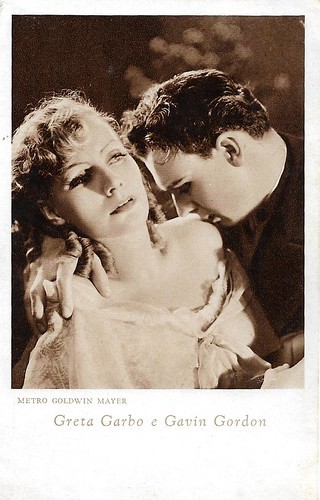
Italian postcard by Cinema-Illustrazione, Milano, Series 2, no. 1. Photo: Metro-Goldwyn-Mayer. Greta Garbo and Gavin Gordon in the early sound film Romance (Clarence Brown, 1930). It was also issued as a silent film.
Swedish Greta Garbo (1905-1990) was one of the greatest and most glamorous film stars ever produced by the Hollywood studio system. She was part of the Golden Age of the silent cinema of the 1920s and was one of the few actors who made a glorious transition to the talkies. She started her career in European cinema and would always stay more popular in Europe than in the USA.
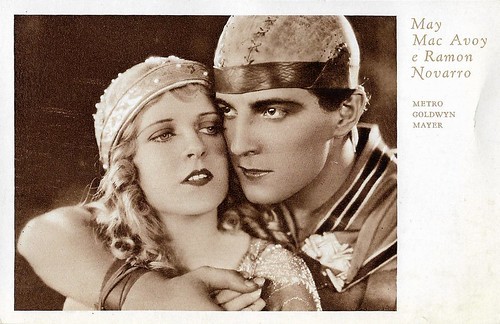
Italian postcard by Cinema-Illustrazione, Milano, Series 2, no. 2. Photo: Metro-Goldwyn-Mayer. Ramon Novarro and May McAvoy in Ben-Hur (Fred Niblo, 1925).
Mexican-American actor Ramon Novarro (1899-1968) was a popular Latin Lover of the 1920s and early 1930s. He was the star of silent Hollywood's biggest epic, Ben-Hur (Fred Niblo, 1925).
May McAvoy (1899-1984), also written as MacAvoy and Mac Avoy, was an American actress of the silent screen, best known as Esther in the classic epic Ben-Hur (Fred Niblo, 1925).
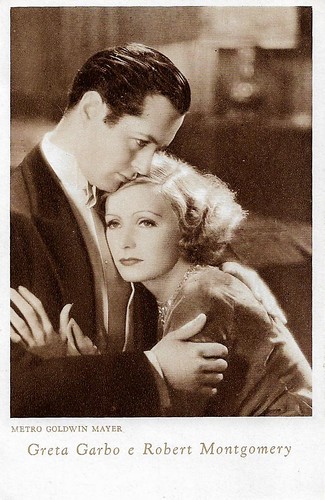
Italian postcard by Cinema-Illustrazione, Milano, Series 2, no. 3. Photo: Metro-Goldwyn-Mayer. Greta Garbo and Robert Montgomery in Inspiration (Clarence Brown, 1931).
Robert Montgomery (1904-1981) was left penniless at the age of sixteen, and became a mechanic's mate on a railway, a deckhand, and finally property man to a touring company, which resulted in a stage career. Played in stock for some time, mostly old man characters, and eventually reached New York. Film debut in So This is College (1929), while after Private Lives (1931) with Norma Shearer he became a star. Memorable pictures with him were The Big House (1930), Inspiration (1931), Hell Below (1933), No More Ladies (1935), Piccadilly Jim (1936), Mr. & Mrs. Smith (1941), and Here Comes Mr. Jordan (1941). From 1945 he directed films too, such as the Film Noir Lady in the Lake (1946).
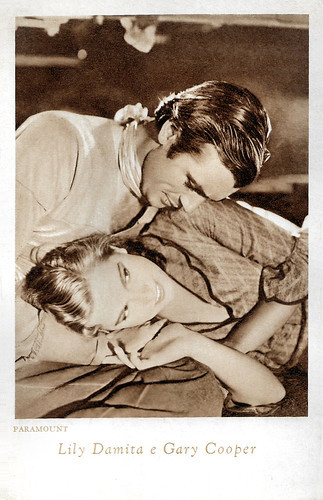
Italian postcard by Cinema-Illustrazione, Milano, series 2, no. 4. Photo: Paramount. Lily Damita and Gary Cooper in Fighting Caravans (Otto Brower, David Burton, 1931).
Beautiful and seductive French actress Lily Damita (1902-1994) appeared in 33 French, Austrian, and Hollywood films between 1922 and 1937. Her marriage with Errol Flynn was rather tempestuous and led to her nickname 'Dynamita'.
American screen legend Gary Cooper (1901-1961) is well remembered for his stoic, understated acting style in more than one hundred Westerns, comedies and dramas. He received five Oscar nominations and won twice for his roles as Alvin York in Sergeant York (1941) and as Will Kane in High Noon (1952).
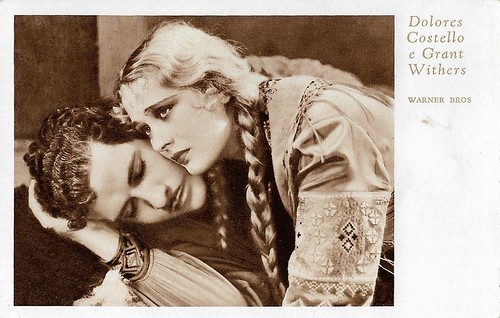
Italian postcard by Cinema-Illustrazione, Milano, series 2, no. 8. Photo: Warner Bros. Dolores Costello and Grant Withers in Hearts in Exile (Michael Curtiz, 1929).
American film actress Dolores Costello (1903-1979) was 'The Goddess of the Silent Screen'. She was Hollywood royalty: the daughter of popular matinee idol Maurice Costello, wife of John Barrymore, and grandmother of Drew Barrymore.
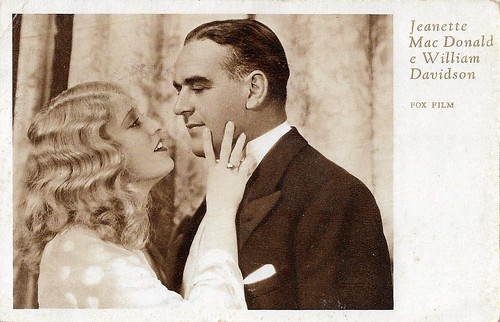
Italian postcard by Cinema-Illustrazione, Milano, series 2, no. 9. Photo: Fox Film. Jeanette MacDonald and William Davidson possibly in Oh, for Man!(Hamilton MacFadden, 1931).
Red-headed and blue-green-eyed operatic singer Jeanette MacDonald (1903-1965) was discovered for the cinema by Ernst Lubitsch, who cast her opposite Maurice Chevalier in The Love Parade (1929). Later 'the Iron Butterfly' co-starred with Nelson Eddy in a string of successful musicals and played opposite Clark Gable in San Francisco (1936).
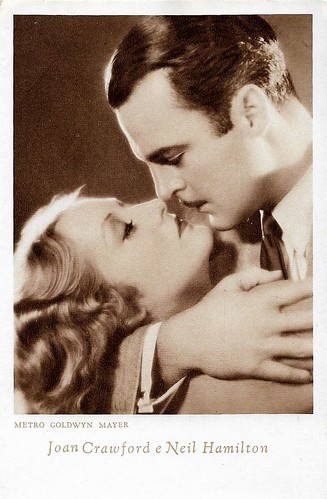
Italian postcard by Cinema-Illustrazione, Milano, series 2, no. 11. Photo: Metro-Goldwyn-Mayer. Joan Crawford and Neil Hamilton in Laughing Sinners (Harry Beaumont, 1931).
Joan Crawford 's (1905-1977) Hollywood career spanned many decades, studios, and controversies. In her silent films, she made an impact as a vivacious Jazz Age flapper and later she matured into a star of psychological melodramas.
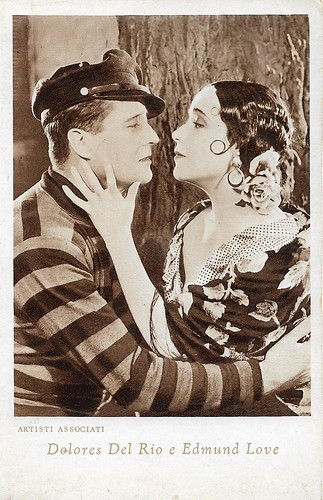
Italian postcard by Cinema-Illustrazione, Milano, series 2, no. 13. Photo: United Artists (Artisti Associati). Dolores Del Río and Edmund Lowe in The Bad One (George Fitzmaurice, 1930).
Mexican and American actress Dolores del Río (1905–1983) was a Hollywood star in the 1920s and 1930s, and one of the most important female actresses of the Golden Age of Mexican cinema in the 1940s and 1950s. Del Río was the first major Latin cross-over star in Hollywood and was considered one of the most beautiful faces that have emerged in Hollywood cinema. She also appeared in several European films.
Edmund Lowe (1890-1971) was an American actor of silent and sound cinema, best known for his parts in Raul Walsh's WWI drama What Price Glory (1926) in which he rivals with Victor McLaglen over the love of Dolores del Rio, in the bittersweet comedy Dinner at Eight (George Cukor, 1933) in which Lowe has an affair with Jean Harlow, and in Dillinger (Max Nosseck, 1945). From 1915 to 1960 he starred in some 100 films.
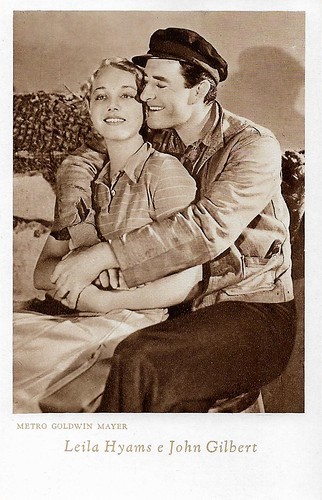
Italian postcard by Cinema-Illustrazione, Milano, series 2, no. 15. Photo: Metro-Goldwyn-Mayer. John Gilbert and Leila Hyams in Way of a Sailor (Sam Wood, 1930)
American actor, screenwriter, and director John Gilbert (1899-1936) rose to fame during the silent film era and became a popular leading man known as 'The Great Lover'.
Charming American model, vaudeville, and film actress Leila Hyams (1905-1977) was one of Hollywood's top leading ladies of the early talkie pre-code years. She had spark, personality, and charisma, and a touch of down-to-earthiness and naturalness that won over movie fans; they could relate to her. She is best known for her roles in the classic horror features Freaks (1932) and Island of Lost Souls (1932). Her career lasted little more than a decade.
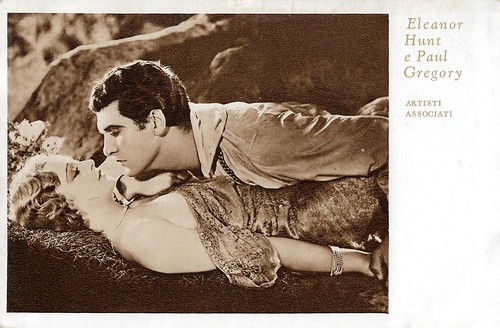
Italian postcard by Cinema-Illustrazione, series 2, no. 21. Photo: United Artists. Eleanor Hunt (1910-1981) and Paul Gregory (1904-1942) in a romantic scene from the film Whoopee (1930), an early sound musical directed by Thornton Freeland and produced by Sam Goldwyn Studios.
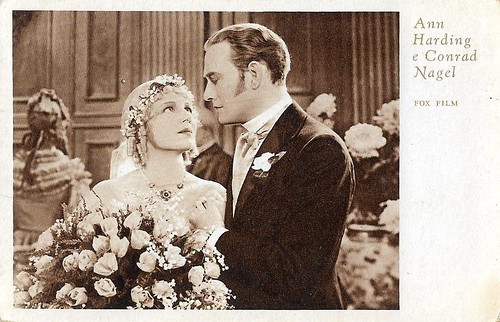
Italian postcard by Cinema-Illustrazione, Milano, series 2, no. 22. Photo: Fox Film. Conrad Nagel and Ann Harding in East Lynne (Frank Lloyd, 1931).
American actor Conrad Nagel (1897-1970) was a tall, blue-eyed matinee idol of the 1920s. He successfully made the transition to sound film.
Ann Harding (1902–1981) was an American film actress. She was signed by Pathe and made her debut in Paris Bound (1929), with Fredric March. She became a leading lady, and the roles that she played were always the same, but her co-stars changed. She was the gentle, refined heroine as in The Animal Kingdom (1932), wherein she played Daisy, the rejected fiancée of Leslie Howard.
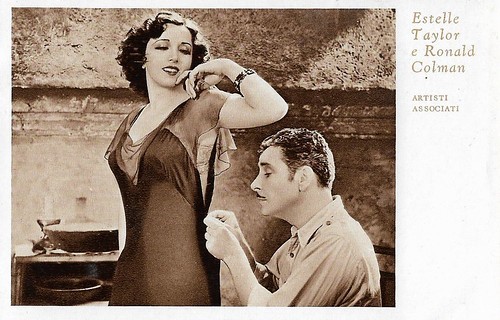
Italian postcard by Cinema-Illustrazione, series 2, no. 24. Photo: United Artists. Estelle Taylor and Ronald Colman in The Unholy Garden (George Fitzmaurice, 1931).
English gentleman-actor Ronald Colman (1891-1958) was a top box office draw in Hollywood films throughout the 1920s, 1930s, and 1940s. ‘The man with the velvet voice’ was nominated for four Academy Awards. In 1948 he finally won the Oscar for his splendid portrayal of a tormented actor in A Double Life.
Estelle Taylor (1894-1958) was an American actress, singer, model, and animal rights activist. With "dark-brown, almost black hair, and brown eyes," she was regarded as one of the most beautiful silent film stars of the 1920s. After her stage debut in 1919, Taylor began appearing in small roles in World and Vitagraph films. She achieved her first notable success with While New York Sleeps (1920). She was a contract player of Fox and later Paramount, but for the most part of her career, she freelanced. She became famous and was commended by critics for her portrayals of historical women in important films: Moses' sister Miriam in The Ten Commandments (1923) starring Theodore Roberts, Mary, Queen of Scots in Dorothy Vernon of Haddon Hall (1924) starring Mary Pickford, and Lucrezia Borgia in Don Juan (1926) starring John Barrymore. Although she made a successful transition to sound films, she retired from film acting in 1932 and decided to focus entirely on her singing career. She was also active in animal welfare before her death from cancer in 1958.
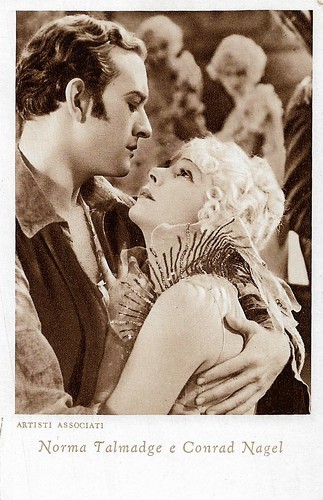
Italian postcard by Cinema-Illustrazione, Milano, series 2, no. 27. Photo: United Artists (Artisti Associati). Conrad Nagel and Norma Talmadge in Du Barry, Woman of Passion (Sam Taylor, 1930).
American actor Conrad Nagel (1897-1970) was a tall, blue-eyed matinee idol of the 1920s. He successfully made the transition to sound film.
Norma Talmadge (1894-1957) was an American actress and film producer of the silent era. A major box-office draw for more than a decade, her career reached a peak in the early 1920s, when she ranked among the most popular idols of the American screen.
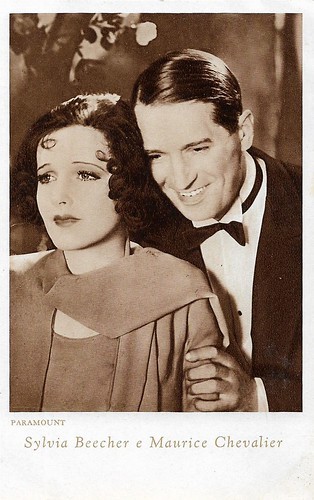
Italian postcard by Cinema-Illustrazione, series 2, no. 29. Photo: Paramount. Maurice Chevalier and Sylvia Beecher in Innocents of Paris (Richard Wallace, 1929).
Maurice Chevalier (1888-1972) was a French actor, singer, and entertainer. His trademark was a casual straw hat, which he always wore on stage with a cane and a tuxedo.
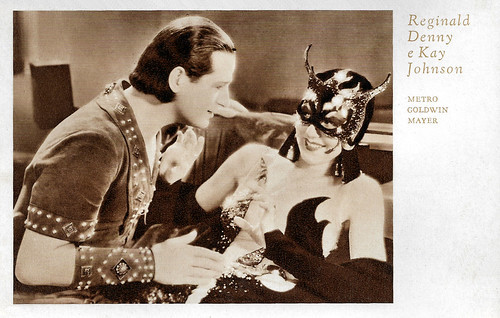
Italian postcard by Cinema-Illustrazione, Milano, series 2, no. 30. Photo: Metro-Goldwyn-Mayer. Kay Johnson and Reginald Denny in Madam Satan (Cecil B. DeMille, 1930).
Kay Johnson, originally Catherine Townsend Johnson (1904-1975), was an American stage and screen actress, who peaked on screen in the early 1930s.
English stage, film, and television actor Reginald Denny (1891-1967) was also an aviator and a pioneer in the field of radio-controlled, pilotless aviation. He appeared in more than 200 films, both in Great Britain and in the United States, first as a lead in silent films and later as a character actor in sound films and TV productions.
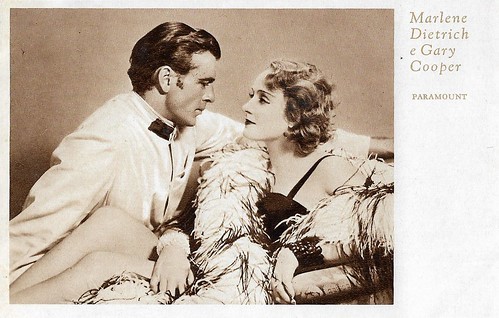
Italian postcard by Cinema-Illustrazione, series 2, no. 31. Photo: Paramount. Marlene Dietrich and Gary Cooper in Morocco (Josef von Sternberg, 1930).
Marlene Dietrich (1901-1992) is regarded as the first German actress to become successful in Hollywood. Throughout her long career, she constantly re-invented herself, starting as a cabaret singer, chorus girl, and film actress in 1920s Berlin, she became a Hollywood movie star in the 1930s, a World War II frontline entertainer, and finally an international stage show performer from the 1950s to the 1970s, eventually becoming one of the entertainment icons of the 20th century.
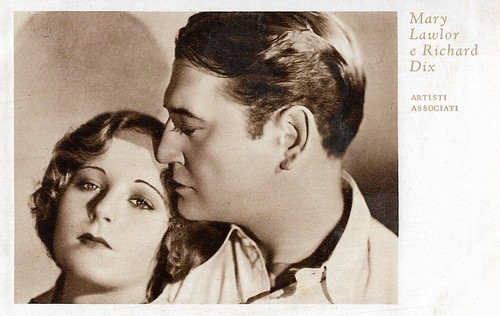
Italian postcard by Cinema-Illustrazione, series 2, no. 32. Photo: United Artists. Richard Dix and Mary Lawlor in Shooting Straight (George Archainbaud, 1930).
American film actor Richard Dix (1893–1949) achieved popularity in both silent and sound film, first as the rugged and stalwart hero in countless Westerns, then dramatic features such as Cecil B. DeMille's The Ten Commandments (1923). After his years of silent film at Paramount, and thanks to his deep voice and commanding presence, he became a well-known star at RKO in the 1930s. He was nominated for the Academy Award for Best Actor for his lead role in the Best Picture-winning epic, Cimarron (1931).
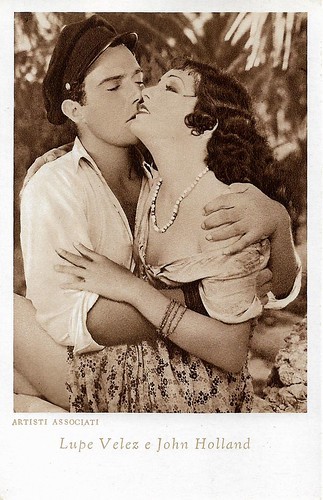
Italian postcard by Cinema-Illustrazione, Milano, series 2, no. 34. Photo: United Artists (Artisti Associati). Lupe Velez and John Holland in Hell Harbor (Henry King, 1930), produced by Inspiration Pictures and distributed by United Artists.
Lupe Velez (1908-1944), was one of the first Mexican actresses to succeed in Hollywood. Her nicknames were 'The Mexican Spitfire' and 'Hot Pepper'. She was the leading lady in such silent films as The Gaucho (1927), Lady of the Pavements (1928), and Wolf Song (1929). During the 1930s, her well-known explosive screen persona was exploited in a series of successful films like Hot Pepper (1933), Strictly Dynamite (1934), and Hollywood Party (1934). In the 1940s, Vélez's popularity peaked after appearing in the Mexican Spitfire films, a series created to capitalise on Vélez's well-documented fiery personality. She had several highly publicised romances and a stormy marriage. In 1944, Vélez died of an intentional overdose of the barbiturate drug Seconal. Her death and the circumstances surrounding it have been the subject of speculation and controversy.
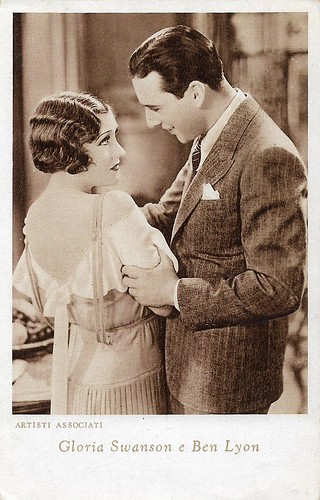
Italian postcard by Cinema-Illustrazione, series 2, no. 35. United Artists. Gloria Swanson and Ben Lyon in Indiscreet (Leo McCarey, 1931). The film was remade in 1958 with Ingrid Bergman and Cary Grant.
Gloria Swanson (1899-1983) was one of the biggest Hollywood stars of the silent era. She transformed from a typical Mack Sennett comedienne into a lively, provocative, even predatory, star in films by Cecil B. De Mille. She received Oscar nominations for Sadie Thompson (1928), The Trespasser (1929), and Sunset Blvd. (1950).
Ben Lyon (1901-1979) was an American stage, film, radio, and TV performer, as well as a studio manager. He is famous for his part as the war aviator in Hell's Angels (1930).
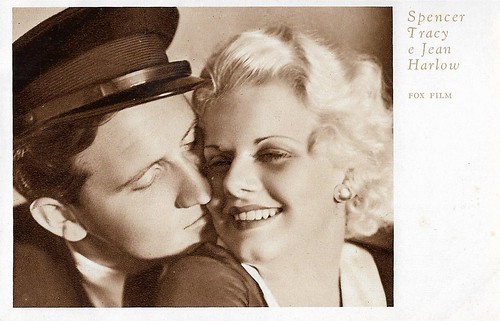
Italian postcard by Cinema-Illustrazione, series 2, no. 36. Spencer Tracy and Jean Harlow in Goldie (Benjamin Stoloff, 1931), a remake of Howard Hawks' silent film A Girl in Every Port (1928).
American film actress Jean Harlow (1911–1937) was one of the sex symbols of the 1930s. With her come-hither body, platinum blonde hair, and a keen sense of humour, she had her breakthrough in Howard Hughes' World War I epic Hell's Angels (1930). Frank Capra's Platinum Blonde (1931) cemented her role as America's new sex symbol. In 1932, she signed with Metro-Goldwyn-Mayer and became the leading lady in a string of hit films. These included Red Dust (1932), Dinner at Eight (1933), Reckless (1935), and Suzy (1936). Among her frequent co-stars were William Powell, Spencer Tracy, and, in six films, Clark Gable.
American actor Spencer Tracy (1900-1967) was one of the major stars of Hollywood's Golden Age. He was the first actor to win back-to-back Oscars for Captains Courageous (1937) with Freddie Bartholomew, and for playing Father Edward Flanagan in Boys Town (1938) with Mickey Rooney. Considered by his peers as one of the best Hollywood actors, Tracy was noted for his natural performing style and versatility.
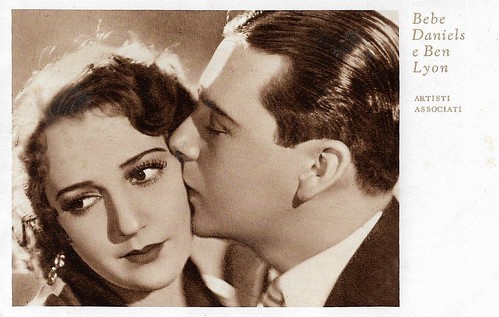
Italian postcard by Cinema-Illustrazione, series 2, no. 37. Photo: United Artists. Ben Lyon and Bebe Daniels in Alias French Gertie (George Archainbaud, 1930).
Bebe Daniels (1901-1971) began her career in Hollywood during the silent film era as a child actress. She later became the love interest of Harold Lloyd in dozens of short comedies. Cecil B. de Mille made her a silent star and later she sang and danced in early musicals like Rio Rita (1929) and 42nd Street (1933). In Great Britain, she gained further fame on stage, radio, and television. In her long career, Bebe Daniels appeared in 230 films.
Ben Lyon (1901-1979) was an American stage, film, radio, and TV performer, as well as a studio manager. He is famous for his part as the war aviator in Hell's Angels (1930).
Check out the first and the second post on Cinema-Illustrazione. For the editions of the magazine Cinema-Illustrazione between 1930 and 1939, see the website of the Centro Sperimentale. And check out the Cinema Illustrazione page at the recently updated Ross Verlag website (thanks to Jean Ritsema).

Italian postcard by Cinema-Illustrazione, Milano, Series 2, no. 1. Photo: Metro-Goldwyn-Mayer. Greta Garbo and Gavin Gordon in the early sound film Romance (Clarence Brown, 1930). It was also issued as a silent film.
Swedish Greta Garbo (1905-1990) was one of the greatest and most glamorous film stars ever produced by the Hollywood studio system. She was part of the Golden Age of the silent cinema of the 1920s and was one of the few actors who made a glorious transition to the talkies. She started her career in European cinema and would always stay more popular in Europe than in the USA.

Italian postcard by Cinema-Illustrazione, Milano, Series 2, no. 2. Photo: Metro-Goldwyn-Mayer. Ramon Novarro and May McAvoy in Ben-Hur (Fred Niblo, 1925).
Mexican-American actor Ramon Novarro (1899-1968) was a popular Latin Lover of the 1920s and early 1930s. He was the star of silent Hollywood's biggest epic, Ben-Hur (Fred Niblo, 1925).
May McAvoy (1899-1984), also written as MacAvoy and Mac Avoy, was an American actress of the silent screen, best known as Esther in the classic epic Ben-Hur (Fred Niblo, 1925).

Italian postcard by Cinema-Illustrazione, Milano, Series 2, no. 3. Photo: Metro-Goldwyn-Mayer. Greta Garbo and Robert Montgomery in Inspiration (Clarence Brown, 1931).
Robert Montgomery (1904-1981) was left penniless at the age of sixteen, and became a mechanic's mate on a railway, a deckhand, and finally property man to a touring company, which resulted in a stage career. Played in stock for some time, mostly old man characters, and eventually reached New York. Film debut in So This is College (1929), while after Private Lives (1931) with Norma Shearer he became a star. Memorable pictures with him were The Big House (1930), Inspiration (1931), Hell Below (1933), No More Ladies (1935), Piccadilly Jim (1936), Mr. & Mrs. Smith (1941), and Here Comes Mr. Jordan (1941). From 1945 he directed films too, such as the Film Noir Lady in the Lake (1946).

Italian postcard by Cinema-Illustrazione, Milano, series 2, no. 4. Photo: Paramount. Lily Damita and Gary Cooper in Fighting Caravans (Otto Brower, David Burton, 1931).
Beautiful and seductive French actress Lily Damita (1902-1994) appeared in 33 French, Austrian, and Hollywood films between 1922 and 1937. Her marriage with Errol Flynn was rather tempestuous and led to her nickname 'Dynamita'.
American screen legend Gary Cooper (1901-1961) is well remembered for his stoic, understated acting style in more than one hundred Westerns, comedies and dramas. He received five Oscar nominations and won twice for his roles as Alvin York in Sergeant York (1941) and as Will Kane in High Noon (1952).

Italian postcard by Cinema-Illustrazione, Milano, series 2, no. 8. Photo: Warner Bros. Dolores Costello and Grant Withers in Hearts in Exile (Michael Curtiz, 1929).
American film actress Dolores Costello (1903-1979) was 'The Goddess of the Silent Screen'. She was Hollywood royalty: the daughter of popular matinee idol Maurice Costello, wife of John Barrymore, and grandmother of Drew Barrymore.

Italian postcard by Cinema-Illustrazione, Milano, series 2, no. 9. Photo: Fox Film. Jeanette MacDonald and William Davidson possibly in Oh, for Man!(Hamilton MacFadden, 1931).
Red-headed and blue-green-eyed operatic singer Jeanette MacDonald (1903-1965) was discovered for the cinema by Ernst Lubitsch, who cast her opposite Maurice Chevalier in The Love Parade (1929). Later 'the Iron Butterfly' co-starred with Nelson Eddy in a string of successful musicals and played opposite Clark Gable in San Francisco (1936).

Italian postcard by Cinema-Illustrazione, Milano, series 2, no. 11. Photo: Metro-Goldwyn-Mayer. Joan Crawford and Neil Hamilton in Laughing Sinners (Harry Beaumont, 1931).
Joan Crawford 's (1905-1977) Hollywood career spanned many decades, studios, and controversies. In her silent films, she made an impact as a vivacious Jazz Age flapper and later she matured into a star of psychological melodramas.

Italian postcard by Cinema-Illustrazione, Milano, series 2, no. 13. Photo: United Artists (Artisti Associati). Dolores Del Río and Edmund Lowe in The Bad One (George Fitzmaurice, 1930).
Mexican and American actress Dolores del Río (1905–1983) was a Hollywood star in the 1920s and 1930s, and one of the most important female actresses of the Golden Age of Mexican cinema in the 1940s and 1950s. Del Río was the first major Latin cross-over star in Hollywood and was considered one of the most beautiful faces that have emerged in Hollywood cinema. She also appeared in several European films.
Edmund Lowe (1890-1971) was an American actor of silent and sound cinema, best known for his parts in Raul Walsh's WWI drama What Price Glory (1926) in which he rivals with Victor McLaglen over the love of Dolores del Rio, in the bittersweet comedy Dinner at Eight (George Cukor, 1933) in which Lowe has an affair with Jean Harlow, and in Dillinger (Max Nosseck, 1945). From 1915 to 1960 he starred in some 100 films.

Italian postcard by Cinema-Illustrazione, Milano, series 2, no. 15. Photo: Metro-Goldwyn-Mayer. John Gilbert and Leila Hyams in Way of a Sailor (Sam Wood, 1930)
American actor, screenwriter, and director John Gilbert (1899-1936) rose to fame during the silent film era and became a popular leading man known as 'The Great Lover'.
Charming American model, vaudeville, and film actress Leila Hyams (1905-1977) was one of Hollywood's top leading ladies of the early talkie pre-code years. She had spark, personality, and charisma, and a touch of down-to-earthiness and naturalness that won over movie fans; they could relate to her. She is best known for her roles in the classic horror features Freaks (1932) and Island of Lost Souls (1932). Her career lasted little more than a decade.

Italian postcard by Cinema-Illustrazione, series 2, no. 21. Photo: United Artists. Eleanor Hunt (1910-1981) and Paul Gregory (1904-1942) in a romantic scene from the film Whoopee (1930), an early sound musical directed by Thornton Freeland and produced by Sam Goldwyn Studios.

Italian postcard by Cinema-Illustrazione, Milano, series 2, no. 22. Photo: Fox Film. Conrad Nagel and Ann Harding in East Lynne (Frank Lloyd, 1931).
American actor Conrad Nagel (1897-1970) was a tall, blue-eyed matinee idol of the 1920s. He successfully made the transition to sound film.
Ann Harding (1902–1981) was an American film actress. She was signed by Pathe and made her debut in Paris Bound (1929), with Fredric March. She became a leading lady, and the roles that she played were always the same, but her co-stars changed. She was the gentle, refined heroine as in The Animal Kingdom (1932), wherein she played Daisy, the rejected fiancée of Leslie Howard.

Italian postcard by Cinema-Illustrazione, series 2, no. 24. Photo: United Artists. Estelle Taylor and Ronald Colman in The Unholy Garden (George Fitzmaurice, 1931).
English gentleman-actor Ronald Colman (1891-1958) was a top box office draw in Hollywood films throughout the 1920s, 1930s, and 1940s. ‘The man with the velvet voice’ was nominated for four Academy Awards. In 1948 he finally won the Oscar for his splendid portrayal of a tormented actor in A Double Life.
Estelle Taylor (1894-1958) was an American actress, singer, model, and animal rights activist. With "dark-brown, almost black hair, and brown eyes," she was regarded as one of the most beautiful silent film stars of the 1920s. After her stage debut in 1919, Taylor began appearing in small roles in World and Vitagraph films. She achieved her first notable success with While New York Sleeps (1920). She was a contract player of Fox and later Paramount, but for the most part of her career, she freelanced. She became famous and was commended by critics for her portrayals of historical women in important films: Moses' sister Miriam in The Ten Commandments (1923) starring Theodore Roberts, Mary, Queen of Scots in Dorothy Vernon of Haddon Hall (1924) starring Mary Pickford, and Lucrezia Borgia in Don Juan (1926) starring John Barrymore. Although she made a successful transition to sound films, she retired from film acting in 1932 and decided to focus entirely on her singing career. She was also active in animal welfare before her death from cancer in 1958.

Italian postcard by Cinema-Illustrazione, Milano, series 2, no. 27. Photo: United Artists (Artisti Associati). Conrad Nagel and Norma Talmadge in Du Barry, Woman of Passion (Sam Taylor, 1930).
American actor Conrad Nagel (1897-1970) was a tall, blue-eyed matinee idol of the 1920s. He successfully made the transition to sound film.
Norma Talmadge (1894-1957) was an American actress and film producer of the silent era. A major box-office draw for more than a decade, her career reached a peak in the early 1920s, when she ranked among the most popular idols of the American screen.

Italian postcard by Cinema-Illustrazione, series 2, no. 29. Photo: Paramount. Maurice Chevalier and Sylvia Beecher in Innocents of Paris (Richard Wallace, 1929).
Maurice Chevalier (1888-1972) was a French actor, singer, and entertainer. His trademark was a casual straw hat, which he always wore on stage with a cane and a tuxedo.

Italian postcard by Cinema-Illustrazione, Milano, series 2, no. 30. Photo: Metro-Goldwyn-Mayer. Kay Johnson and Reginald Denny in Madam Satan (Cecil B. DeMille, 1930).
Kay Johnson, originally Catherine Townsend Johnson (1904-1975), was an American stage and screen actress, who peaked on screen in the early 1930s.
English stage, film, and television actor Reginald Denny (1891-1967) was also an aviator and a pioneer in the field of radio-controlled, pilotless aviation. He appeared in more than 200 films, both in Great Britain and in the United States, first as a lead in silent films and later as a character actor in sound films and TV productions.

Italian postcard by Cinema-Illustrazione, series 2, no. 31. Photo: Paramount. Marlene Dietrich and Gary Cooper in Morocco (Josef von Sternberg, 1930).
Marlene Dietrich (1901-1992) is regarded as the first German actress to become successful in Hollywood. Throughout her long career, she constantly re-invented herself, starting as a cabaret singer, chorus girl, and film actress in 1920s Berlin, she became a Hollywood movie star in the 1930s, a World War II frontline entertainer, and finally an international stage show performer from the 1950s to the 1970s, eventually becoming one of the entertainment icons of the 20th century.

Italian postcard by Cinema-Illustrazione, series 2, no. 32. Photo: United Artists. Richard Dix and Mary Lawlor in Shooting Straight (George Archainbaud, 1930).
American film actor Richard Dix (1893–1949) achieved popularity in both silent and sound film, first as the rugged and stalwart hero in countless Westerns, then dramatic features such as Cecil B. DeMille's The Ten Commandments (1923). After his years of silent film at Paramount, and thanks to his deep voice and commanding presence, he became a well-known star at RKO in the 1930s. He was nominated for the Academy Award for Best Actor for his lead role in the Best Picture-winning epic, Cimarron (1931).

Italian postcard by Cinema-Illustrazione, Milano, series 2, no. 34. Photo: United Artists (Artisti Associati). Lupe Velez and John Holland in Hell Harbor (Henry King, 1930), produced by Inspiration Pictures and distributed by United Artists.
Lupe Velez (1908-1944), was one of the first Mexican actresses to succeed in Hollywood. Her nicknames were 'The Mexican Spitfire' and 'Hot Pepper'. She was the leading lady in such silent films as The Gaucho (1927), Lady of the Pavements (1928), and Wolf Song (1929). During the 1930s, her well-known explosive screen persona was exploited in a series of successful films like Hot Pepper (1933), Strictly Dynamite (1934), and Hollywood Party (1934). In the 1940s, Vélez's popularity peaked after appearing in the Mexican Spitfire films, a series created to capitalise on Vélez's well-documented fiery personality. She had several highly publicised romances and a stormy marriage. In 1944, Vélez died of an intentional overdose of the barbiturate drug Seconal. Her death and the circumstances surrounding it have been the subject of speculation and controversy.

Italian postcard by Cinema-Illustrazione, series 2, no. 35. United Artists. Gloria Swanson and Ben Lyon in Indiscreet (Leo McCarey, 1931). The film was remade in 1958 with Ingrid Bergman and Cary Grant.
Gloria Swanson (1899-1983) was one of the biggest Hollywood stars of the silent era. She transformed from a typical Mack Sennett comedienne into a lively, provocative, even predatory, star in films by Cecil B. De Mille. She received Oscar nominations for Sadie Thompson (1928), The Trespasser (1929), and Sunset Blvd. (1950).
Ben Lyon (1901-1979) was an American stage, film, radio, and TV performer, as well as a studio manager. He is famous for his part as the war aviator in Hell's Angels (1930).

Italian postcard by Cinema-Illustrazione, series 2, no. 36. Spencer Tracy and Jean Harlow in Goldie (Benjamin Stoloff, 1931), a remake of Howard Hawks' silent film A Girl in Every Port (1928).
American film actress Jean Harlow (1911–1937) was one of the sex symbols of the 1930s. With her come-hither body, platinum blonde hair, and a keen sense of humour, she had her breakthrough in Howard Hughes' World War I epic Hell's Angels (1930). Frank Capra's Platinum Blonde (1931) cemented her role as America's new sex symbol. In 1932, she signed with Metro-Goldwyn-Mayer and became the leading lady in a string of hit films. These included Red Dust (1932), Dinner at Eight (1933), Reckless (1935), and Suzy (1936). Among her frequent co-stars were William Powell, Spencer Tracy, and, in six films, Clark Gable.
American actor Spencer Tracy (1900-1967) was one of the major stars of Hollywood's Golden Age. He was the first actor to win back-to-back Oscars for Captains Courageous (1937) with Freddie Bartholomew, and for playing Father Edward Flanagan in Boys Town (1938) with Mickey Rooney. Considered by his peers as one of the best Hollywood actors, Tracy was noted for his natural performing style and versatility.

Italian postcard by Cinema-Illustrazione, series 2, no. 37. Photo: United Artists. Ben Lyon and Bebe Daniels in Alias French Gertie (George Archainbaud, 1930).
Bebe Daniels (1901-1971) began her career in Hollywood during the silent film era as a child actress. She later became the love interest of Harold Lloyd in dozens of short comedies. Cecil B. de Mille made her a silent star and later she sang and danced in early musicals like Rio Rita (1929) and 42nd Street (1933). In Great Britain, she gained further fame on stage, radio, and television. In her long career, Bebe Daniels appeared in 230 films.
Ben Lyon (1901-1979) was an American stage, film, radio, and TV performer, as well as a studio manager. He is famous for his part as the war aviator in Hell's Angels (1930).
Check out the first and the second post on Cinema-Illustrazione. For the editions of the magazine Cinema-Illustrazione between 1930 and 1939, see the website of the Centro Sperimentale. And check out the Cinema Illustrazione page at the recently updated Ross Verlag website (thanks to Jean Ritsema).
Published on April 14, 2021 22:00
April 13, 2021
Olga San Juan
American actress, dancer, and comedian Olga San Juan (1927-2009) was mainly active in films during the 1940s. San Juan was dubbed the 'Puerto Rican Pepperpot' or 'Beauty Siren' for singing and dancing roles alongside Bing Crosby, Fred Astaire, and many others.
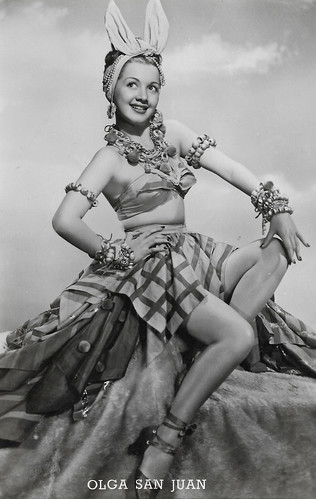
Dutch postcard by Van Leer's Fotodrukindustrie N.V., Amsterdam. Photo: Paramount Pictures. Olga San Juan in Blue Skies (Stuart Heisler, 1946).
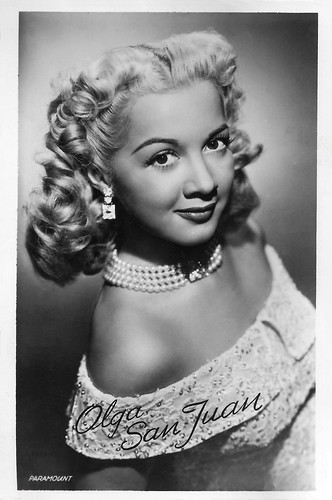
Dutch postcard, no. 3517. Photo: Paramount.
The first dyed-blonde Latin movie spitfire
Olga San Juan was born in Brooklyn, New York to Puerto Rican parents in 1927. When she was 3 years old, her family moved back to Puerto Rico, then moved back to the United States again a few years later. This time, they settled in 'Spanish Harlem'.
While still a toddler, Olga was enrolled in both ballet and flamenco dancing classes and was encouraged to pursue a performing arts career by her stage mother. When she was eleven years old, she and five other school girls performed the Latin dance the Fandango for President Franklin D. Roosevelt.
She went on to perform at such Latin clubs as the Copacabana in New York City. She worked as a dancer with famed jazz and mambo musician, Tito Puente, who by then had earned the title of 'The King of Latin Music'
After talent scouts found her performing her popular nightclub act, Olga San Juan and Her Rumba Band, on radio, she signed a contract with Paramount Pictures in 1943. She appeared in a musical short film called Caribbean Romance (Lester Fuller, 1943) with Eric Blore.
She possessed the same tiny frame and fervid temperament as Brazilian Carmen Miranda. Her film debut was followed by another short film called Bombalera (Noel Madison, 1945), which was nominated for an Oscar. She decided to become the first dyed-blonde Latin movie spitfire. In this, Olga was billed, appropriately enough, as 'The Cuban Cyclone'.
She was front and center in her third short, The Little Witch (George Templeton, 1945), a musical romance in which she virtually played herself as a nightclub singer. Her first role in a feature film was in the musical comedy Rainbow Island (Ralph Murphy, 1944), starring Dorothy Lamour and Eddie Bracken.
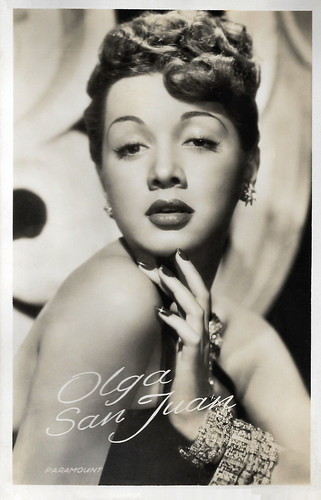
Dutch postcard, no. 3395. Photo: Paramount, 1946.
Paired up, engagingly, with another comedy scene-stealer
Olga San Juan's breakthrough came after the war with the Technicolor musical Blue Skies (Stuart Heisler, 1946) with Bing Crosby, Fred Astaire, and Joan Caulfield. San Juan performed several musical numbers (including 'Heat Wave') in the film, based on a story by Irving Berlin and showcasing his songs. Olga was paired up, engagingly, with another comedy scene-stealer, Billy De Wolfe.
Next, she got a big part in the B-musical Variety Girl (George Marshall, 1947), also starring Mary Hatcher. Numerous Paramount Pictures contract players made cameos or performed songs in it, including Bob Hope and Bing Crosby.
She next co-starred with Donald O'Connor in Are You With It? (Jack Hively, 1948), a musical comedy film about a young insurance man who quits his job to join a traveling carnival.
Next, she had a supporting part in One Touch of Venus (William A. Seiter, 1948), starring Robert Walker, Ava Gardner , and Dick Haymes. This divine musical comedy was based on the Broadway musical of the same name, a book written by S. J. Perelman and Ogden Nash, with music composed by Kurt Weill.
She often played the cute and spunky antagonist to other leading ladies. That same year, she won an Oscar nomination for The Countess of Monte Cristo (Fred de Cordova, 1948) which featured Sonja Henie in her final Hollywood ice extravaganza.
The following year, San Juan could be seen in the romantic comedy The Beautiful Blonde from Bashful Bend (Preston Sturges, 1949) starring Betty Grable . The film, Sturges' first Technicolor production, was not well received at the time it was released, and was generally conceded to be a disaster – even Betty Grable bad-mouthed it – but its reputation has improved somewhat over time.
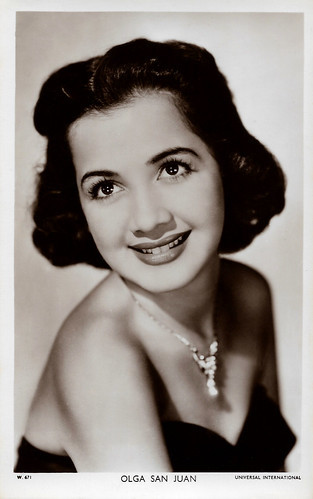
British postcard in the Picturegoer Series, no. W 671. Photo: Universal International.
A flavorful, scene-stealing personality who delightfully mangled the English language
Olga San Juan, unfortunately, did not receive many leading lady opportunities in Hollywood, as she carried with her a heavy Latin accent despite growing up almost exclusively in America.
In 1951, she starred on Broadway in the Lerner and Loewe musical, 'Paint Your Wagon'. She won the Donaldson Award for her work in 'Paint Your Wagon'. However, the show was a flop, running just eight months. Olga had left the cast before the run ended, after becoming pregnant with her second child.
Years before she had met actor Edmond O'Brien at a publicity luncheon for Fox studios, and they were married in 1948. A devout Catholic, San Juan retired to raise their three children: the actors Brendan O'Brien, Maria O'Brien, and television producer Bridget O'Brien, who is married to Barry Adelman, executive producer of the Golden Globe Awards.
In 1954, she returned to the screen with a bit part in the successful drama The Barefoot Contessa (Joseph L. Mankiewicz, 1954), starring Humphrey Bogart, Ava Gardner , and Edmond O'Brien. For his performance, O'Brien won the Academy Award for Best Supporting Actor and the corresponding Golden Globe. She also played a small part in O'Brien's film The 3rd Voice (Hubert Cornfield, 1960).
O'Brien and San Juan were married 28 years, until their divorce in 1976. San Juan's health began to fail after a stroke in the 1970s, but she lived to enjoy her family for decades to come. At age 81, Olga San Juan died in 2009, of kidney failure stemming from a long-term illness at Providence St. Joseph Medical Center, in Burbank, California. She was buried at San Fernando Mission Cemetery in Mission Hills, Los Angeles, California.
She was honoured with the Screen Actors Guild Latino Legacy Award for her work. Gary Brumburgh at IMDb : "for most her career, Puerto Rican singer/dancer Olga San Juan was a welcome distraction by American audiences. A flavorful, scene-stealing personality who delightfully mangled the English language, she decorated a number of war-era and post-war musicals and comedy escapism with her special brand of comedy."
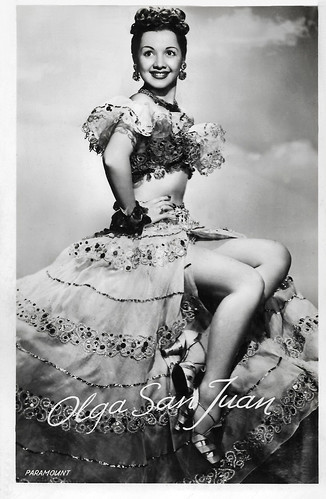
Dutch postcard, no. 3499. Photo: Paramount. Olga San Juan in Blue Skies (Stuart Heisler, 1946).
Sources: Tamara Warta (Love to know), (IMDb), Wikipedia, and .

Dutch postcard by Van Leer's Fotodrukindustrie N.V., Amsterdam. Photo: Paramount Pictures. Olga San Juan in Blue Skies (Stuart Heisler, 1946).

Dutch postcard, no. 3517. Photo: Paramount.
The first dyed-blonde Latin movie spitfire
Olga San Juan was born in Brooklyn, New York to Puerto Rican parents in 1927. When she was 3 years old, her family moved back to Puerto Rico, then moved back to the United States again a few years later. This time, they settled in 'Spanish Harlem'.
While still a toddler, Olga was enrolled in both ballet and flamenco dancing classes and was encouraged to pursue a performing arts career by her stage mother. When she was eleven years old, she and five other school girls performed the Latin dance the Fandango for President Franklin D. Roosevelt.
She went on to perform at such Latin clubs as the Copacabana in New York City. She worked as a dancer with famed jazz and mambo musician, Tito Puente, who by then had earned the title of 'The King of Latin Music'
After talent scouts found her performing her popular nightclub act, Olga San Juan and Her Rumba Band, on radio, she signed a contract with Paramount Pictures in 1943. She appeared in a musical short film called Caribbean Romance (Lester Fuller, 1943) with Eric Blore.
She possessed the same tiny frame and fervid temperament as Brazilian Carmen Miranda. Her film debut was followed by another short film called Bombalera (Noel Madison, 1945), which was nominated for an Oscar. She decided to become the first dyed-blonde Latin movie spitfire. In this, Olga was billed, appropriately enough, as 'The Cuban Cyclone'.
She was front and center in her third short, The Little Witch (George Templeton, 1945), a musical romance in which she virtually played herself as a nightclub singer. Her first role in a feature film was in the musical comedy Rainbow Island (Ralph Murphy, 1944), starring Dorothy Lamour and Eddie Bracken.

Dutch postcard, no. 3395. Photo: Paramount, 1946.
Paired up, engagingly, with another comedy scene-stealer
Olga San Juan's breakthrough came after the war with the Technicolor musical Blue Skies (Stuart Heisler, 1946) with Bing Crosby, Fred Astaire, and Joan Caulfield. San Juan performed several musical numbers (including 'Heat Wave') in the film, based on a story by Irving Berlin and showcasing his songs. Olga was paired up, engagingly, with another comedy scene-stealer, Billy De Wolfe.
Next, she got a big part in the B-musical Variety Girl (George Marshall, 1947), also starring Mary Hatcher. Numerous Paramount Pictures contract players made cameos or performed songs in it, including Bob Hope and Bing Crosby.
She next co-starred with Donald O'Connor in Are You With It? (Jack Hively, 1948), a musical comedy film about a young insurance man who quits his job to join a traveling carnival.
Next, she had a supporting part in One Touch of Venus (William A. Seiter, 1948), starring Robert Walker, Ava Gardner , and Dick Haymes. This divine musical comedy was based on the Broadway musical of the same name, a book written by S. J. Perelman and Ogden Nash, with music composed by Kurt Weill.
She often played the cute and spunky antagonist to other leading ladies. That same year, she won an Oscar nomination for The Countess of Monte Cristo (Fred de Cordova, 1948) which featured Sonja Henie in her final Hollywood ice extravaganza.
The following year, San Juan could be seen in the romantic comedy The Beautiful Blonde from Bashful Bend (Preston Sturges, 1949) starring Betty Grable . The film, Sturges' first Technicolor production, was not well received at the time it was released, and was generally conceded to be a disaster – even Betty Grable bad-mouthed it – but its reputation has improved somewhat over time.

British postcard in the Picturegoer Series, no. W 671. Photo: Universal International.
A flavorful, scene-stealing personality who delightfully mangled the English language
Olga San Juan, unfortunately, did not receive many leading lady opportunities in Hollywood, as she carried with her a heavy Latin accent despite growing up almost exclusively in America.
In 1951, she starred on Broadway in the Lerner and Loewe musical, 'Paint Your Wagon'. She won the Donaldson Award for her work in 'Paint Your Wagon'. However, the show was a flop, running just eight months. Olga had left the cast before the run ended, after becoming pregnant with her second child.
Years before she had met actor Edmond O'Brien at a publicity luncheon for Fox studios, and they were married in 1948. A devout Catholic, San Juan retired to raise their three children: the actors Brendan O'Brien, Maria O'Brien, and television producer Bridget O'Brien, who is married to Barry Adelman, executive producer of the Golden Globe Awards.
In 1954, she returned to the screen with a bit part in the successful drama The Barefoot Contessa (Joseph L. Mankiewicz, 1954), starring Humphrey Bogart, Ava Gardner , and Edmond O'Brien. For his performance, O'Brien won the Academy Award for Best Supporting Actor and the corresponding Golden Globe. She also played a small part in O'Brien's film The 3rd Voice (Hubert Cornfield, 1960).
O'Brien and San Juan were married 28 years, until their divorce in 1976. San Juan's health began to fail after a stroke in the 1970s, but she lived to enjoy her family for decades to come. At age 81, Olga San Juan died in 2009, of kidney failure stemming from a long-term illness at Providence St. Joseph Medical Center, in Burbank, California. She was buried at San Fernando Mission Cemetery in Mission Hills, Los Angeles, California.
She was honoured with the Screen Actors Guild Latino Legacy Award for her work. Gary Brumburgh at IMDb : "for most her career, Puerto Rican singer/dancer Olga San Juan was a welcome distraction by American audiences. A flavorful, scene-stealing personality who delightfully mangled the English language, she decorated a number of war-era and post-war musicals and comedy escapism with her special brand of comedy."

Dutch postcard, no. 3499. Photo: Paramount. Olga San Juan in Blue Skies (Stuart Heisler, 1946).
Sources: Tamara Warta (Love to know), (IMDb), Wikipedia, and .
Published on April 13, 2021 22:00
April 12, 2021
Franz Sala
Franz Sala, aka Francesco Sala (1886-1952) was a prolific actor of the Italian silent cinema, mostly playing the evil antagonist, such as the devil Barbariccia in Maciste all’inferno (Guido Brigone, 1926). In the 1930s he was active as a make-up artist.
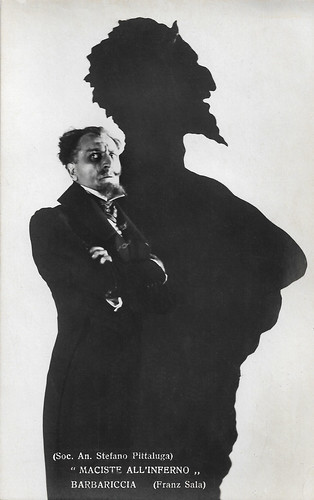
Italian postcard by Ed. A. Traldi, Milano. Franz Sala in Maciste all’inferno (Guido Brigone, 1926).
Almost always as the antagonist and often as evil characters
Francesco "Franz" Sala was born in Alessandria, in 1886. After 11 years at a seminary, he emigrated to South America in 1906, where he had various jobs such as journalist, teacher, salesman, and stage actor.
In 1912 he returned to Italy and debuted in the Ambrosio production Sigfrido/Siegfried (Mario Caserini, 1912) with Mario Voller-Buzzi in the title role.
Later on, Sala worked at Milano Films, in films such as La maschera dell’onestà (1914) and L’ereditiera (1914), both with Hesperia and Livio Pavanelli and directed by Baldassarre Negroni.
When Italy joined the Allies in the First World War, Sala was called to arms and became infantry lieutenant. In 1916 he lost his hearing during a battle at the front lines and was dismissed from the world war conflict.
He retook his work as a film actor, working for various film companies such as Medusa Film (La signorina Ciclone, 1916, with Suzanne Armelle), Milano (Primavera, 1916, with Elettra Raggio), Ambrosio (Lucciola, 1917, with Fernanda Negri-Pouget and Helena Makowska ), Tiber-Film (Mademoiselle Pas-chic, 1918, with Diomira Jacobini ).
During the 1910s, Franz Sala performed in countless films, almost always as the antagonist and often as evil characters, for which he was well-known and praised.
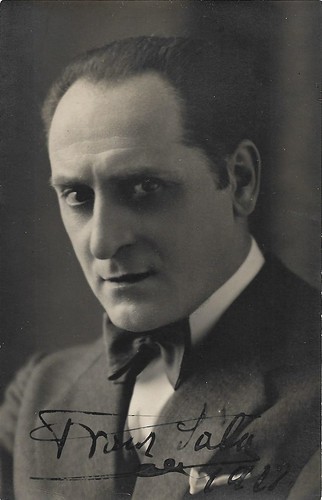
British postcard by T.L.C. Signed 1917.
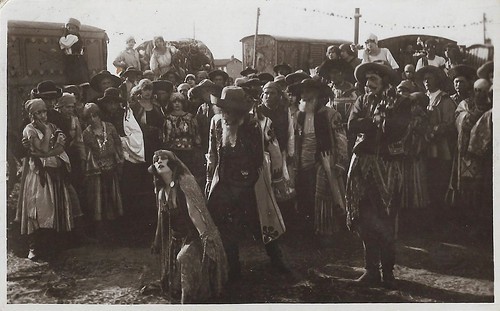
Italian postcard. Photo: Fert. Italia Almirante Manzini , Alfonso Cassini and Franz Sala in Zingari (Mario Almirante, 1920). Caption: Jammadar forces Vielka to marry Gudlo.
A second job as a full-time professional makeup artist
In the 1920s Franz Sala worked often for Stefano Pitaluga’s company Fert Films.
In the early 1920s he appeared for Fert in a whole series of dramas with Italia Almirante Manzini such as L'innamorata (Gennaro Righelli, 1920), Zingari (Mario Almirante, 1920), Marthú che ha visto il diavolo (Almirante 1922), and La chiromante/La maschera del male (1922).
From about 1923 he acted in several adventure films with Domenico Gambino aka Saetta, and from 1924 with Bartolomeo Pagano better known as Maciste in such films as Maciste imperatore (1924), Maciste all’inferno (1926), Maciste contro lo sceicco (1926), Maciste nella gabbia dei leoni (1926), almost all at Fert.
In the late 1920s, Sala continued to act in the films produced by Pittaluga despite the dwindling down of Italian film production, e.g. in the historical productions Beatrice Cenci (1926) and Frate Francesco (1927).
With the advent of sound cinema, Franz Sala stopped acting after a few minor parts in 1930-1931. He became a full-time professional makeup artist. In the 1930s he started to call himself Francesco Sala. His last performance was in 1939 in the film Abuna Messias.
He continued his second job as a makeup artist until 1952. Franz Sala died in Rome in November 1952.
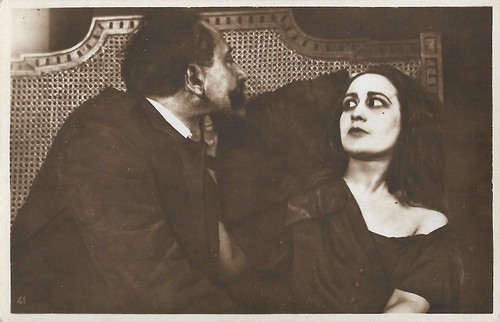
Italian postcard, no. 41. Photo: Fert. Italia Almirante Manzini and Franz Sala in La chiromante aka La maschera del male (Mario Almirante, 1922), starring Italia Almirante Manzini, Lido Manetti and Oreste Bilancia. Caption: The evil man and his stepdaughter.
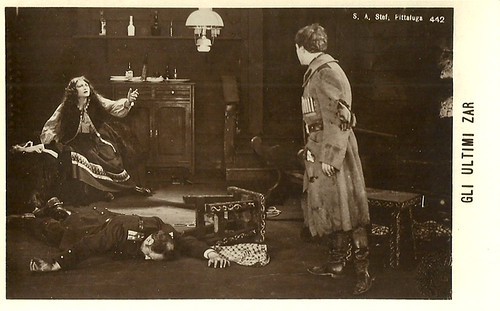
Italian postcard, no. 442. Photo: S.A. Stefano Pittaluga. Elena Lunda, Franz Sala (the corpse on the ground), and Amilcare Taglienti in the Italian late silent film Gli ultimi zar (Baldassarre Negroni, 1928), starring Bartolomeo Pagano aka Maciste.
Sources: Aldo Bernardini/Vittorio Martinelli (Il cinema muto italiano, 1905-1930), Wikipedia (Italian), and .

Italian postcard by Ed. A. Traldi, Milano. Franz Sala in Maciste all’inferno (Guido Brigone, 1926).
Almost always as the antagonist and often as evil characters
Francesco "Franz" Sala was born in Alessandria, in 1886. After 11 years at a seminary, he emigrated to South America in 1906, where he had various jobs such as journalist, teacher, salesman, and stage actor.
In 1912 he returned to Italy and debuted in the Ambrosio production Sigfrido/Siegfried (Mario Caserini, 1912) with Mario Voller-Buzzi in the title role.
Later on, Sala worked at Milano Films, in films such as La maschera dell’onestà (1914) and L’ereditiera (1914), both with Hesperia and Livio Pavanelli and directed by Baldassarre Negroni.
When Italy joined the Allies in the First World War, Sala was called to arms and became infantry lieutenant. In 1916 he lost his hearing during a battle at the front lines and was dismissed from the world war conflict.
He retook his work as a film actor, working for various film companies such as Medusa Film (La signorina Ciclone, 1916, with Suzanne Armelle), Milano (Primavera, 1916, with Elettra Raggio), Ambrosio (Lucciola, 1917, with Fernanda Negri-Pouget and Helena Makowska ), Tiber-Film (Mademoiselle Pas-chic, 1918, with Diomira Jacobini ).
During the 1910s, Franz Sala performed in countless films, almost always as the antagonist and often as evil characters, for which he was well-known and praised.

British postcard by T.L.C. Signed 1917.

Italian postcard. Photo: Fert. Italia Almirante Manzini , Alfonso Cassini and Franz Sala in Zingari (Mario Almirante, 1920). Caption: Jammadar forces Vielka to marry Gudlo.
A second job as a full-time professional makeup artist
In the 1920s Franz Sala worked often for Stefano Pitaluga’s company Fert Films.
In the early 1920s he appeared for Fert in a whole series of dramas with Italia Almirante Manzini such as L'innamorata (Gennaro Righelli, 1920), Zingari (Mario Almirante, 1920), Marthú che ha visto il diavolo (Almirante 1922), and La chiromante/La maschera del male (1922).
From about 1923 he acted in several adventure films with Domenico Gambino aka Saetta, and from 1924 with Bartolomeo Pagano better known as Maciste in such films as Maciste imperatore (1924), Maciste all’inferno (1926), Maciste contro lo sceicco (1926), Maciste nella gabbia dei leoni (1926), almost all at Fert.
In the late 1920s, Sala continued to act in the films produced by Pittaluga despite the dwindling down of Italian film production, e.g. in the historical productions Beatrice Cenci (1926) and Frate Francesco (1927).
With the advent of sound cinema, Franz Sala stopped acting after a few minor parts in 1930-1931. He became a full-time professional makeup artist. In the 1930s he started to call himself Francesco Sala. His last performance was in 1939 in the film Abuna Messias.
He continued his second job as a makeup artist until 1952. Franz Sala died in Rome in November 1952.

Italian postcard, no. 41. Photo: Fert. Italia Almirante Manzini and Franz Sala in La chiromante aka La maschera del male (Mario Almirante, 1922), starring Italia Almirante Manzini, Lido Manetti and Oreste Bilancia. Caption: The evil man and his stepdaughter.

Italian postcard, no. 442. Photo: S.A. Stefano Pittaluga. Elena Lunda, Franz Sala (the corpse on the ground), and Amilcare Taglienti in the Italian late silent film Gli ultimi zar (Baldassarre Negroni, 1928), starring Bartolomeo Pagano aka Maciste.
Sources: Aldo Bernardini/Vittorio Martinelli (Il cinema muto italiano, 1905-1930), Wikipedia (Italian), and .
Published on April 12, 2021 22:00
Paul van Yperen's Blog
- Paul van Yperen's profile
- 13 followers
Paul van Yperen isn't a Goodreads Author
(yet),
but they
do have a blog,
so here are some recent posts imported from
their feed.



